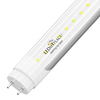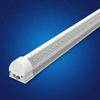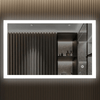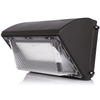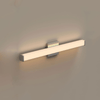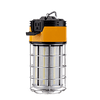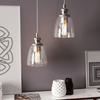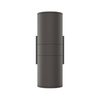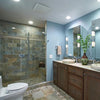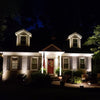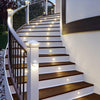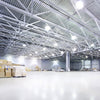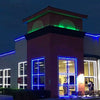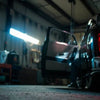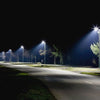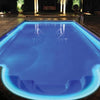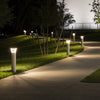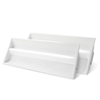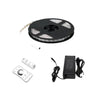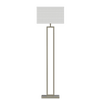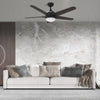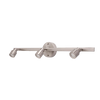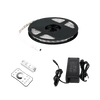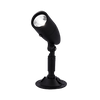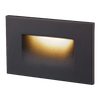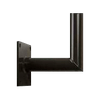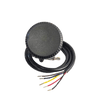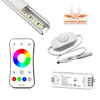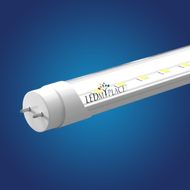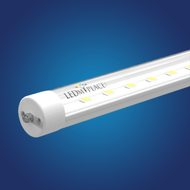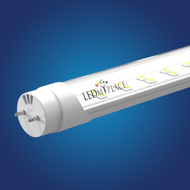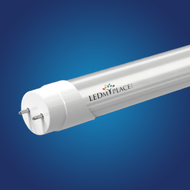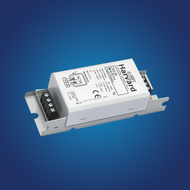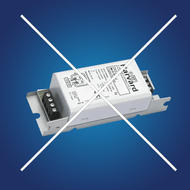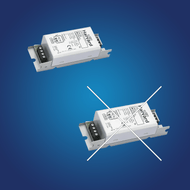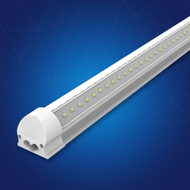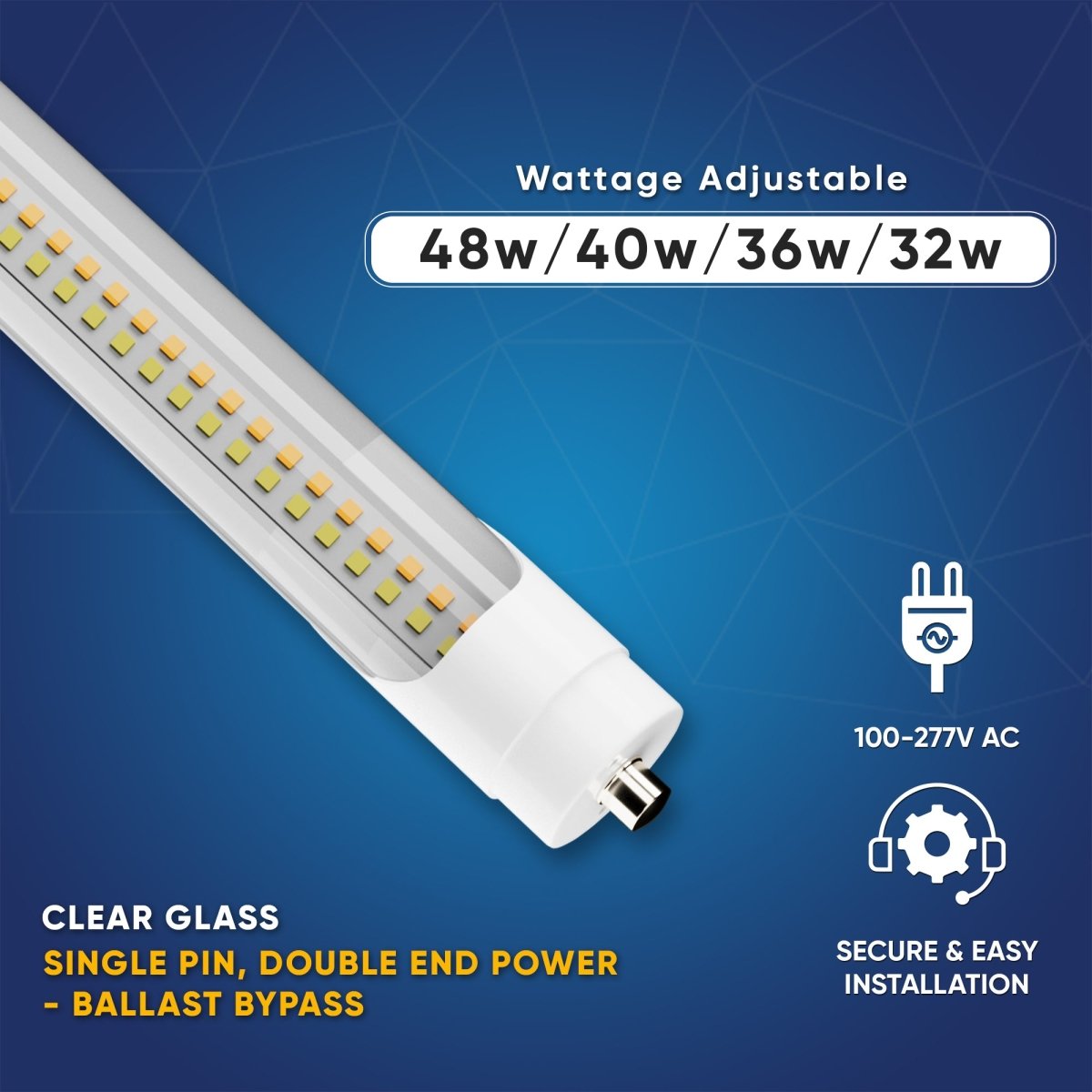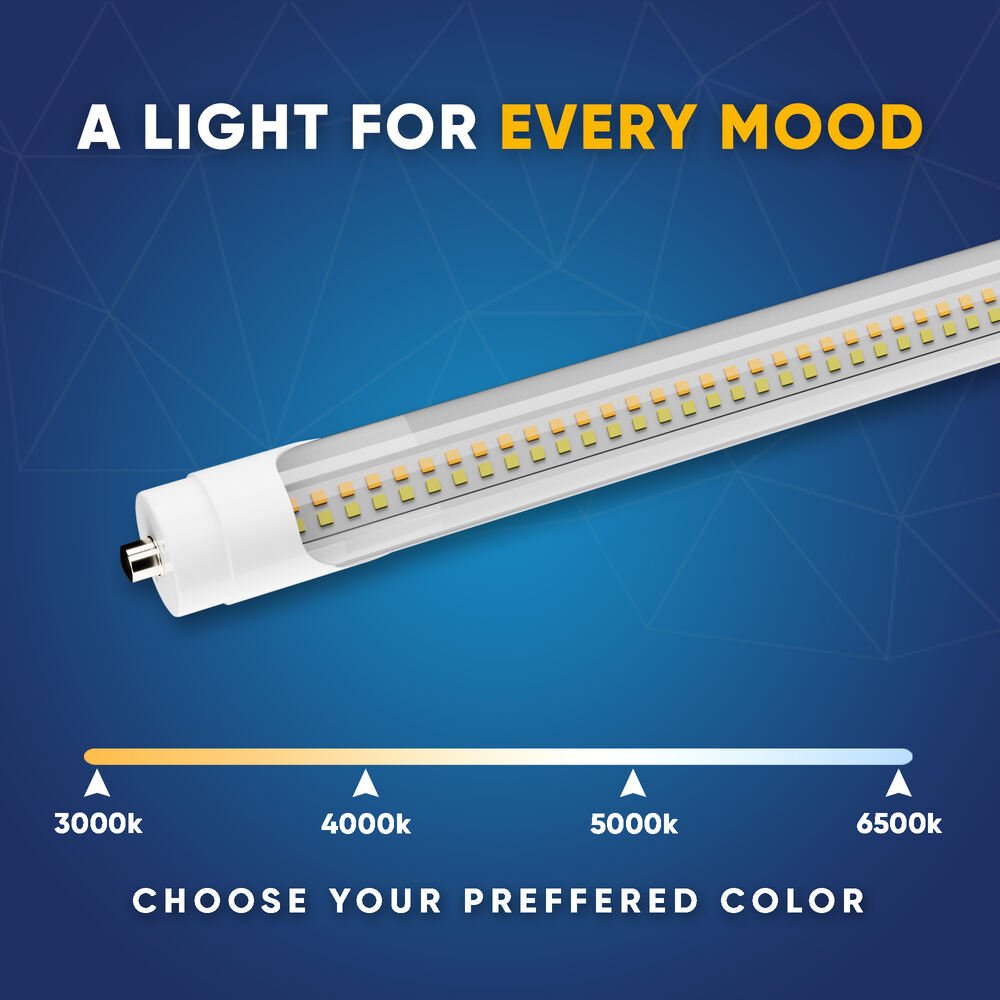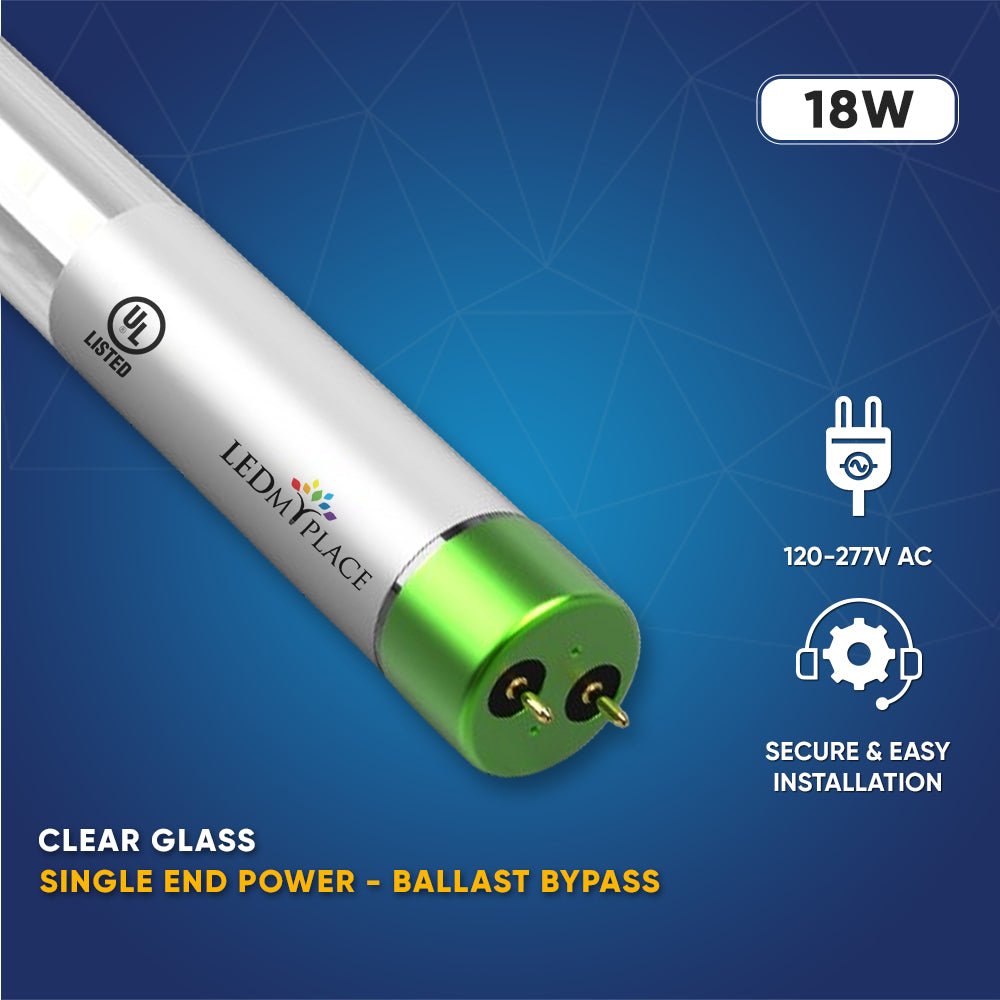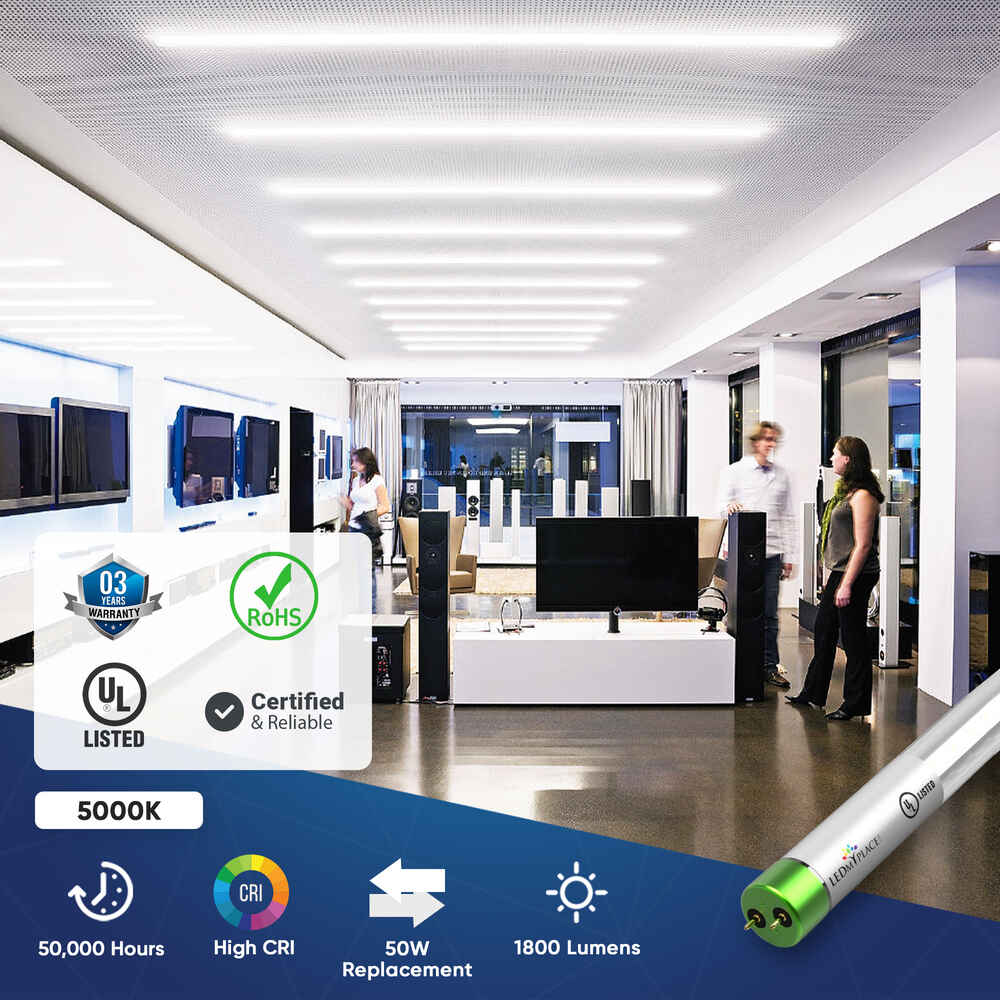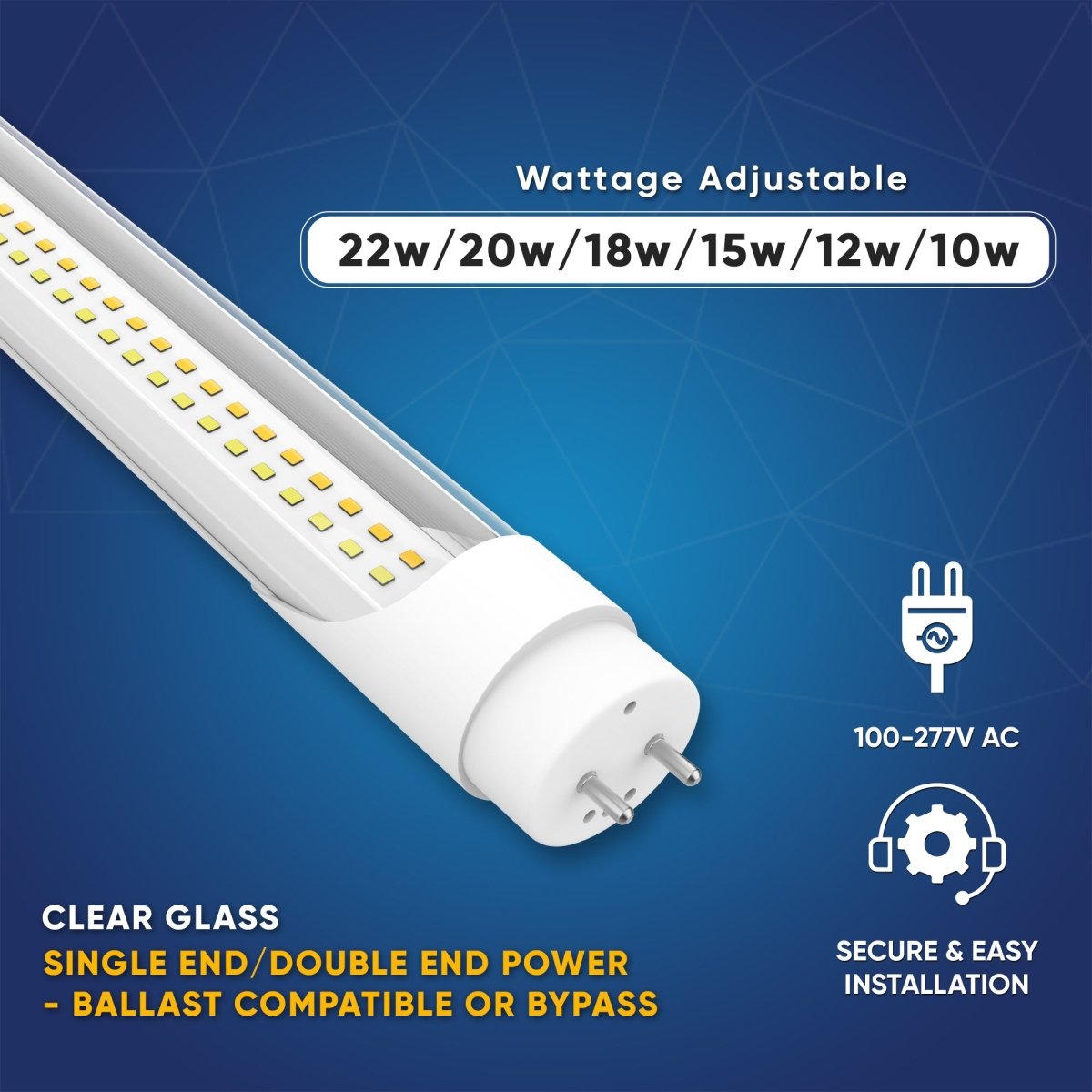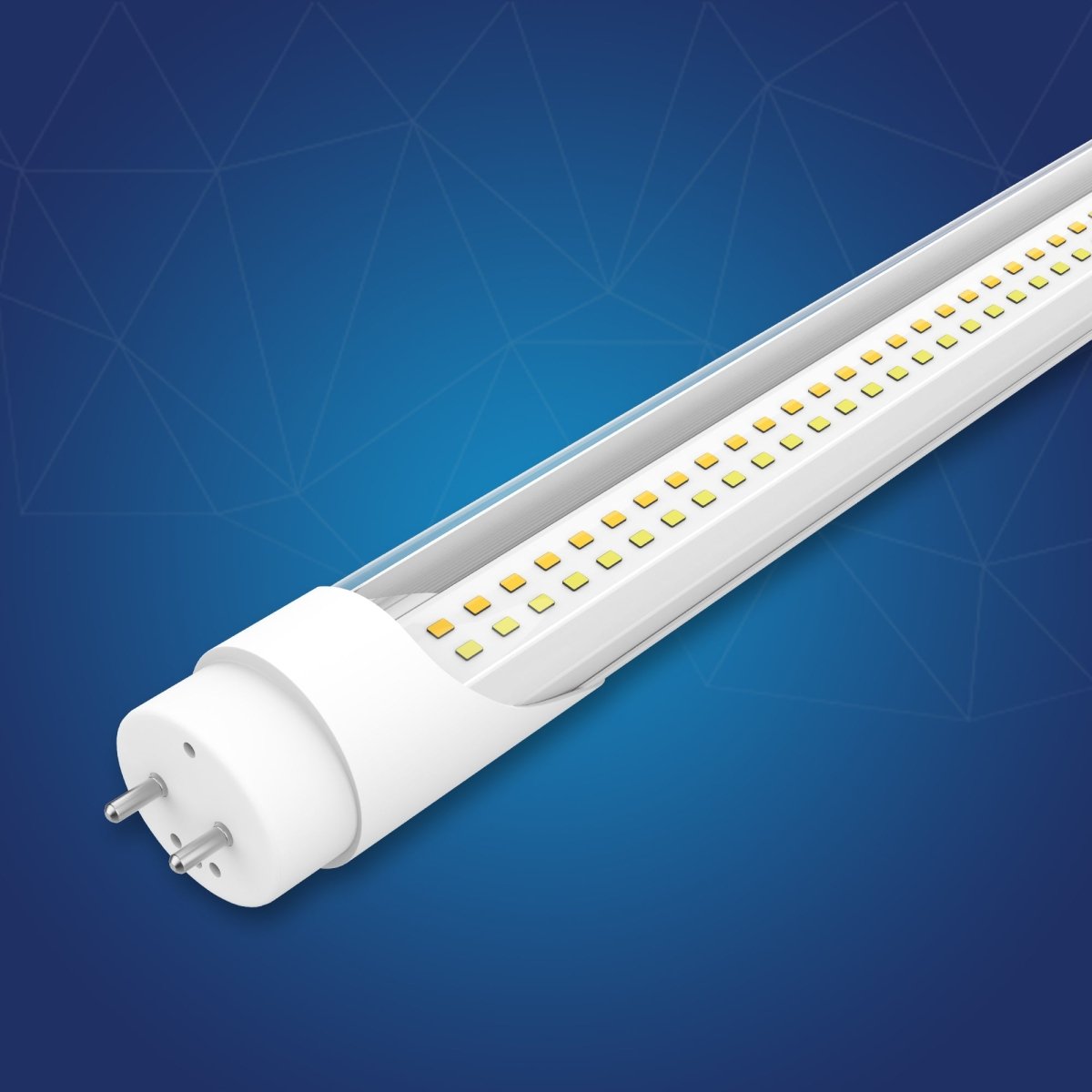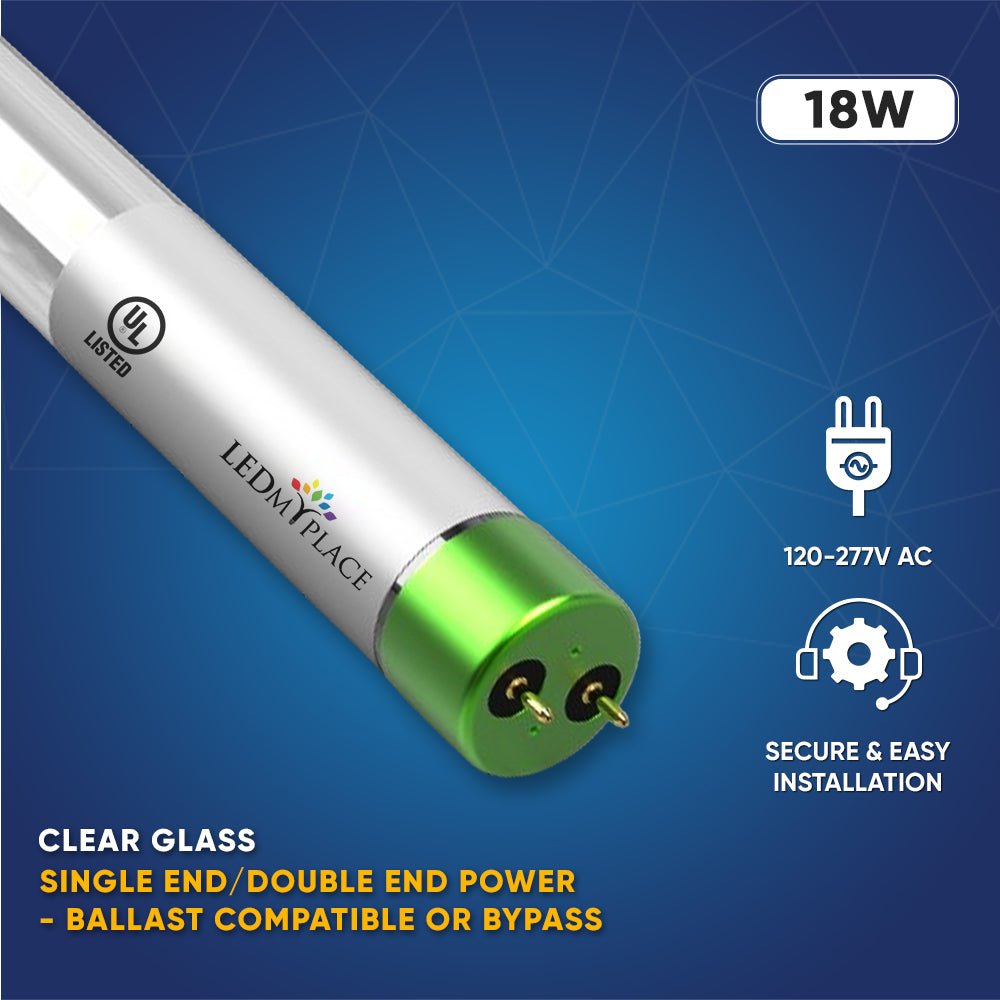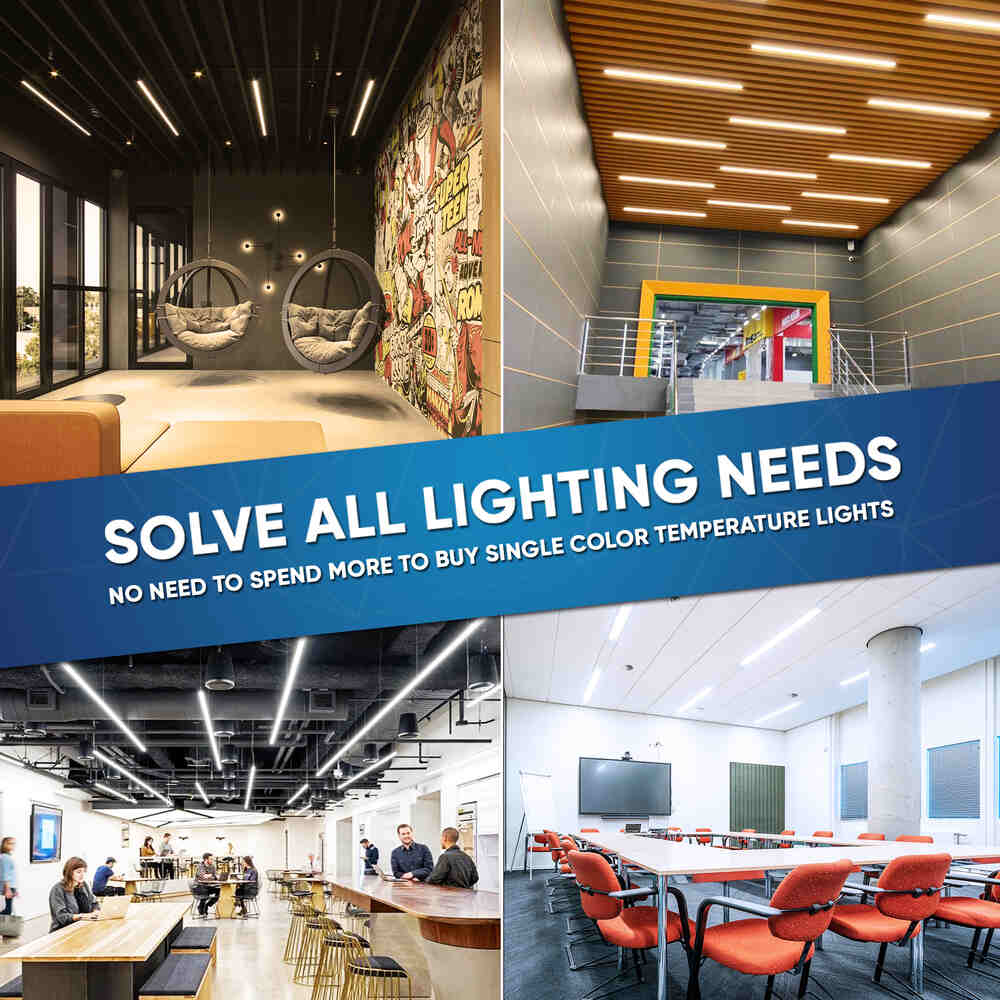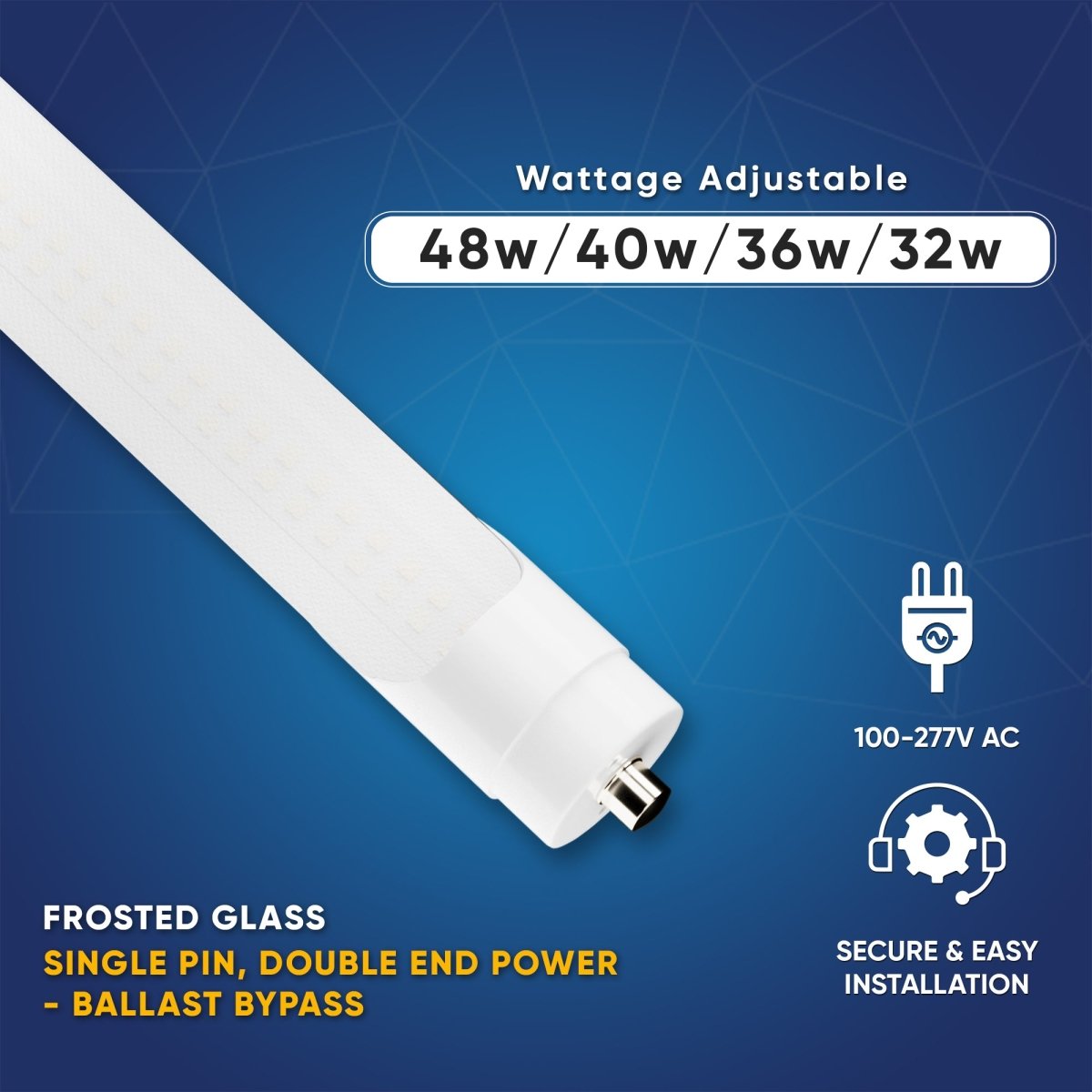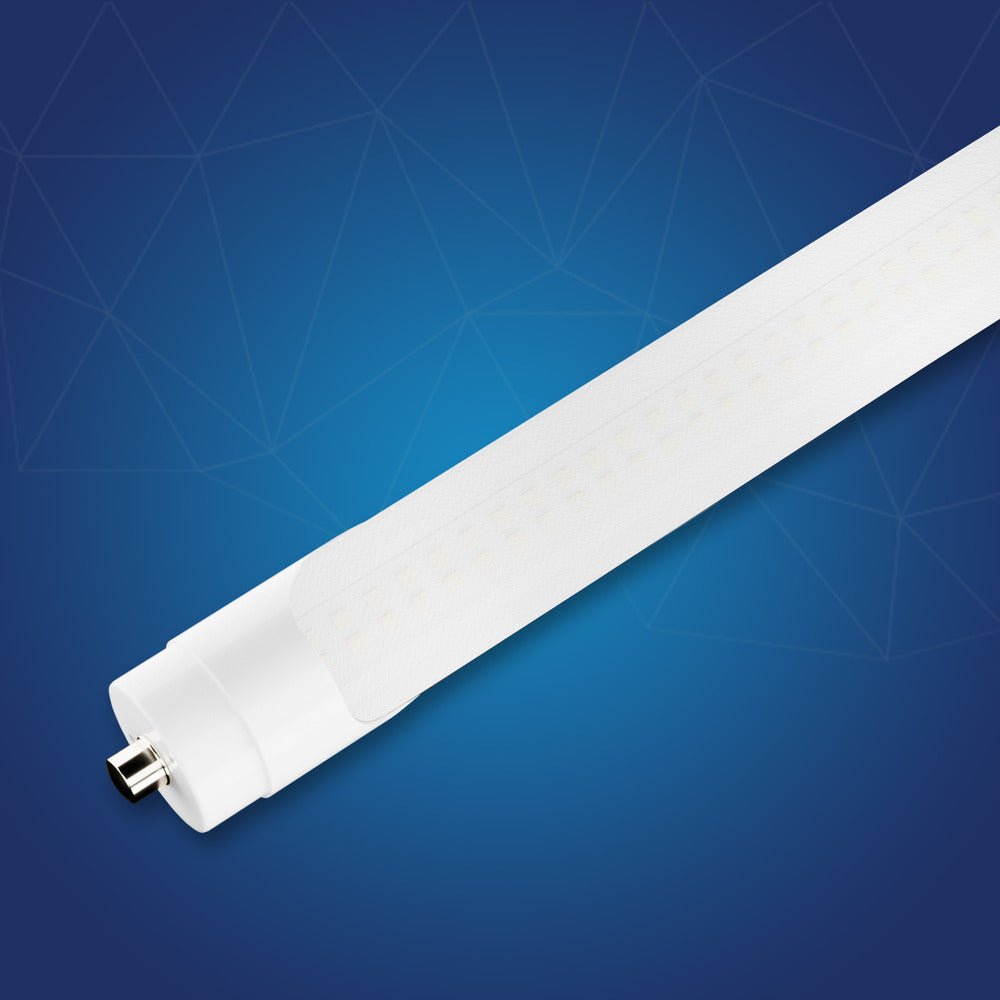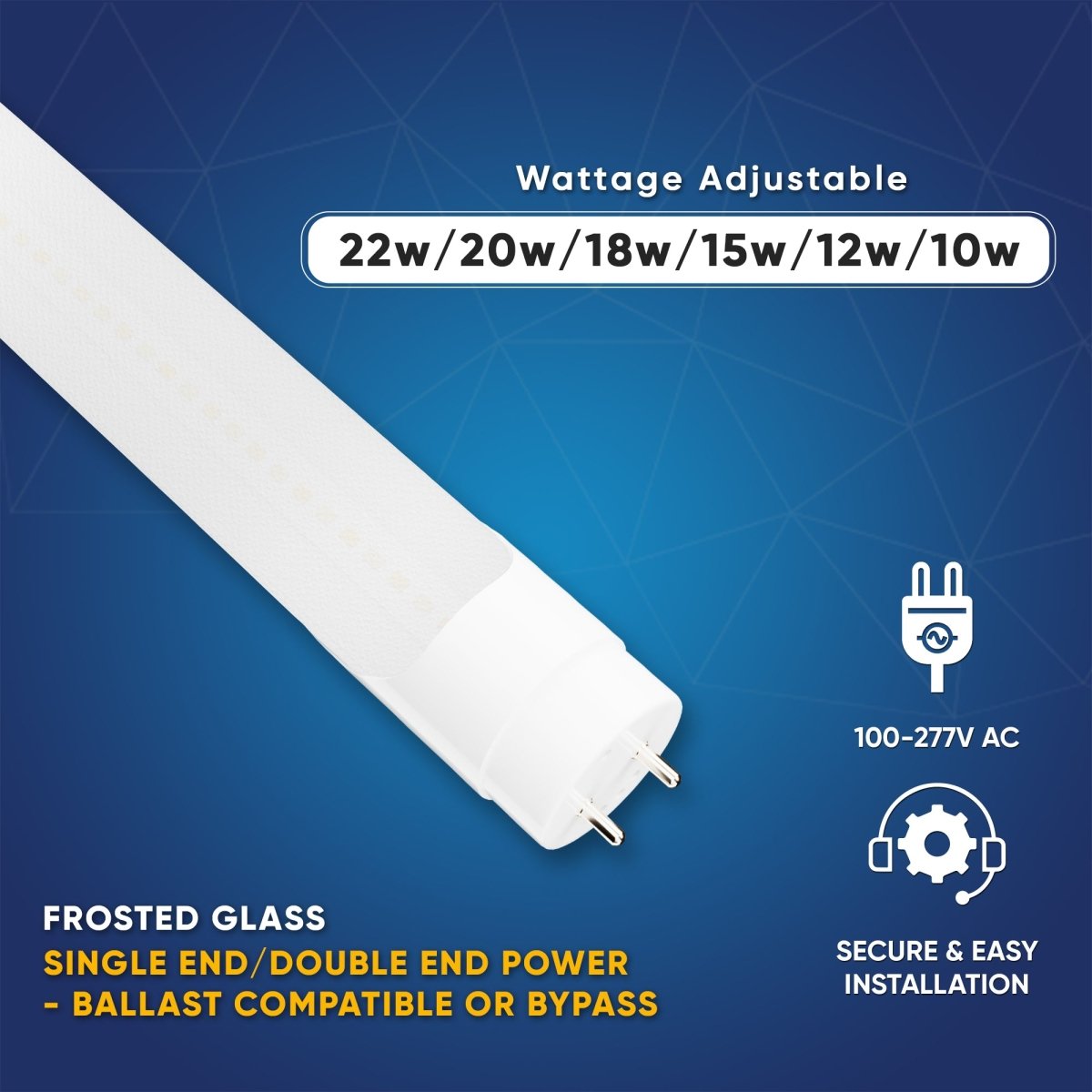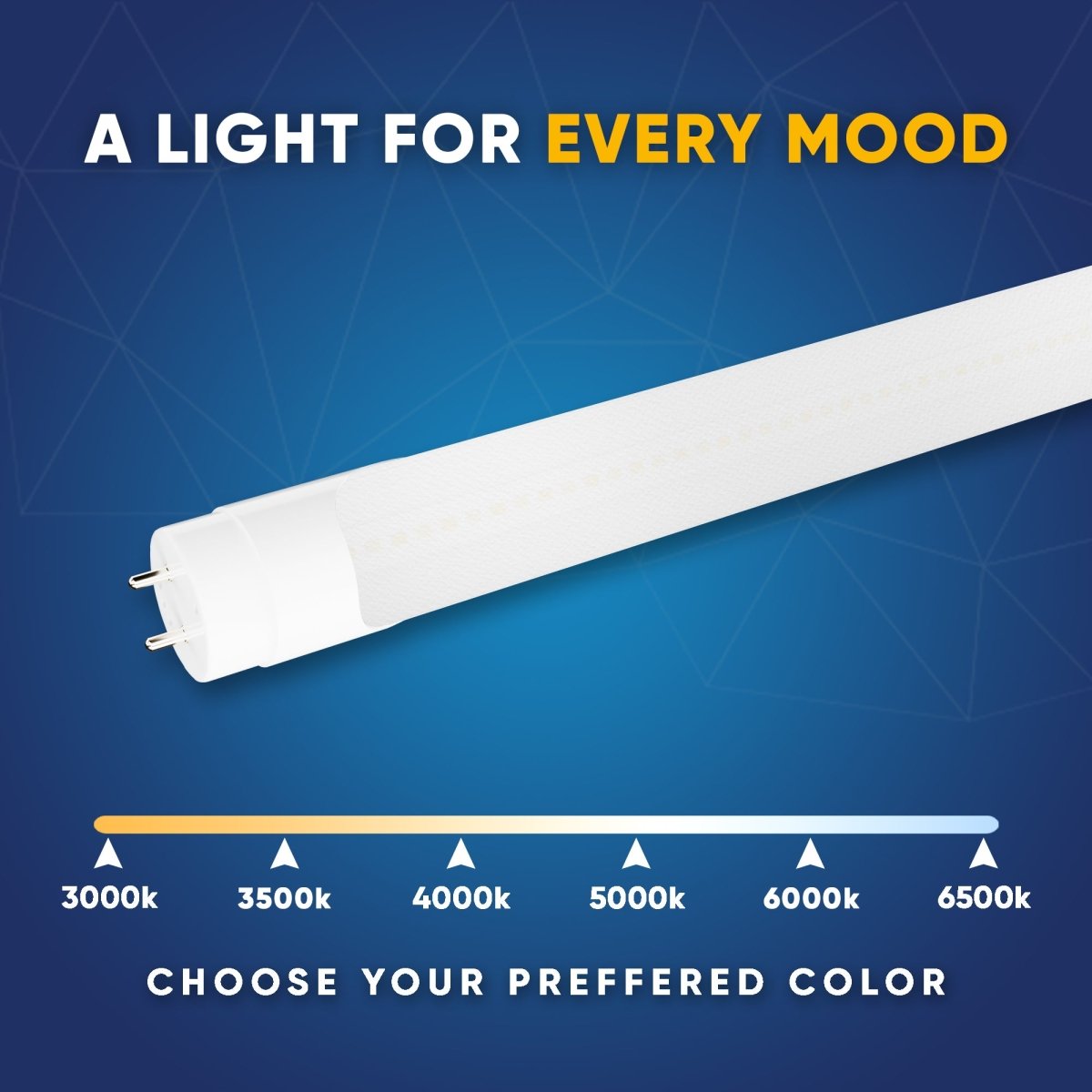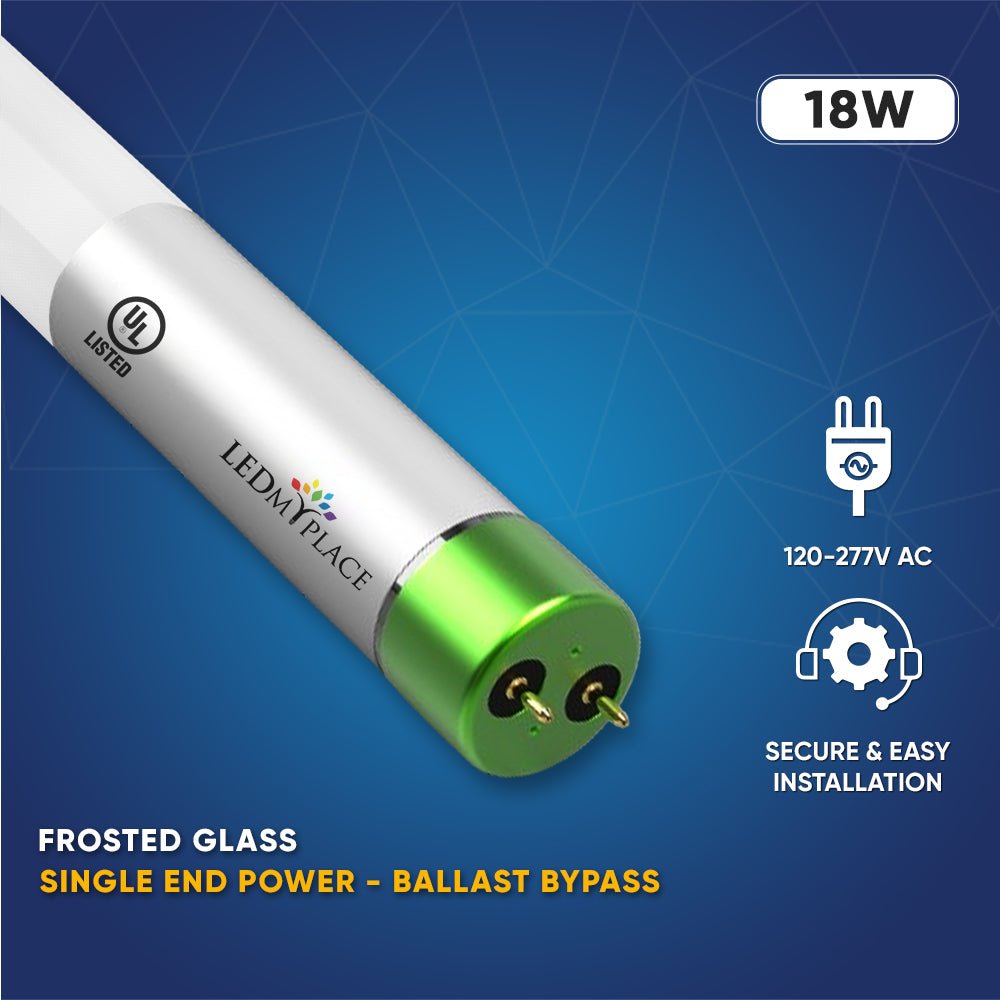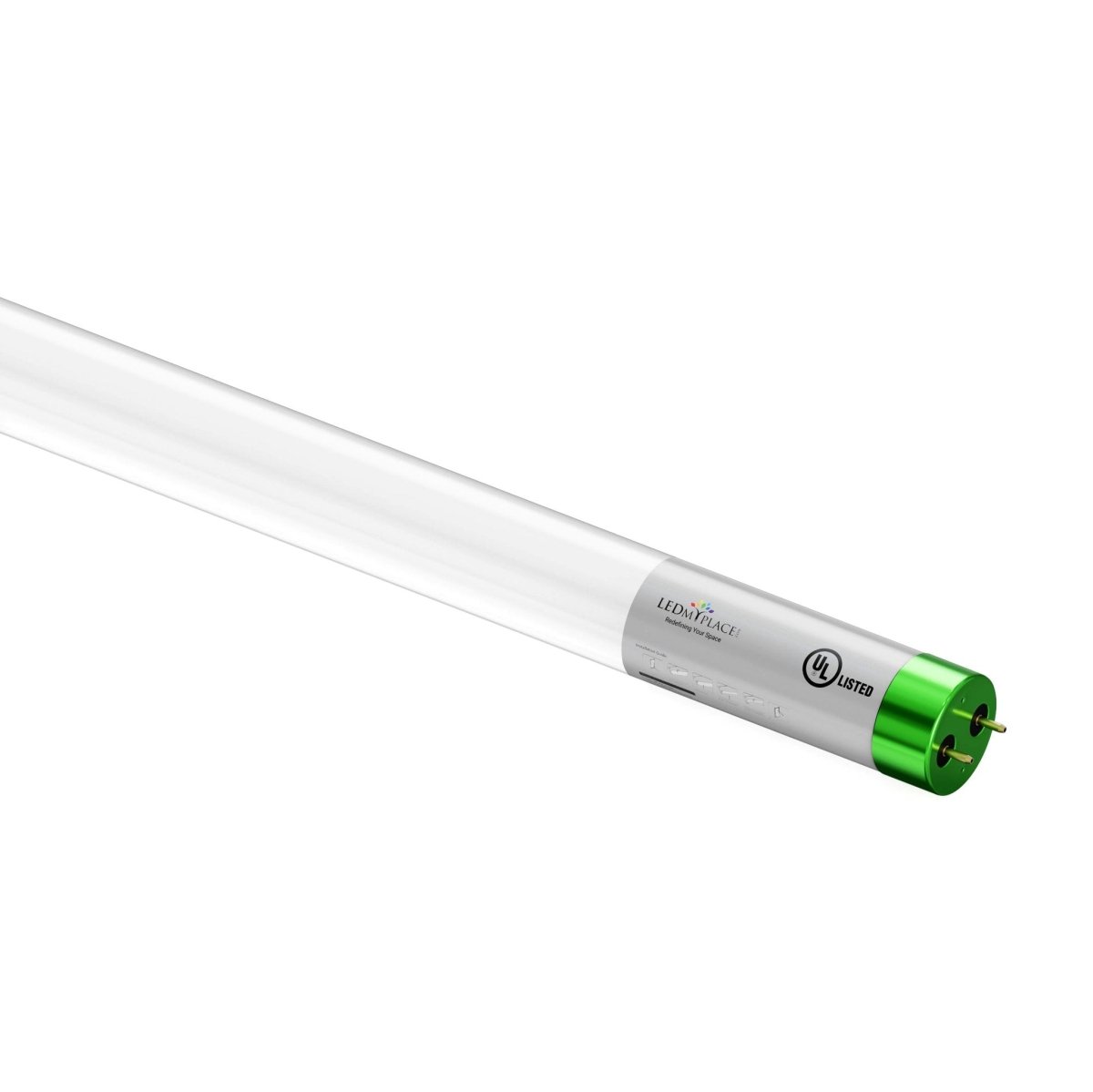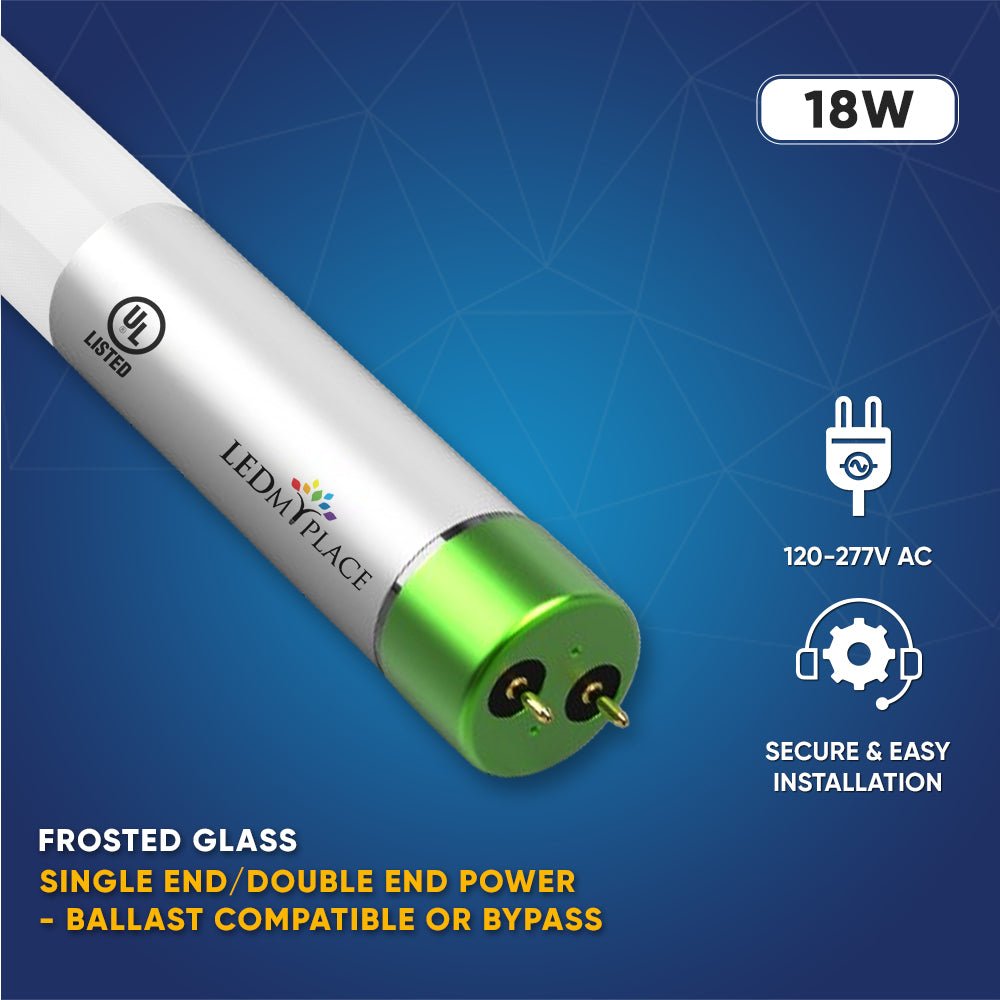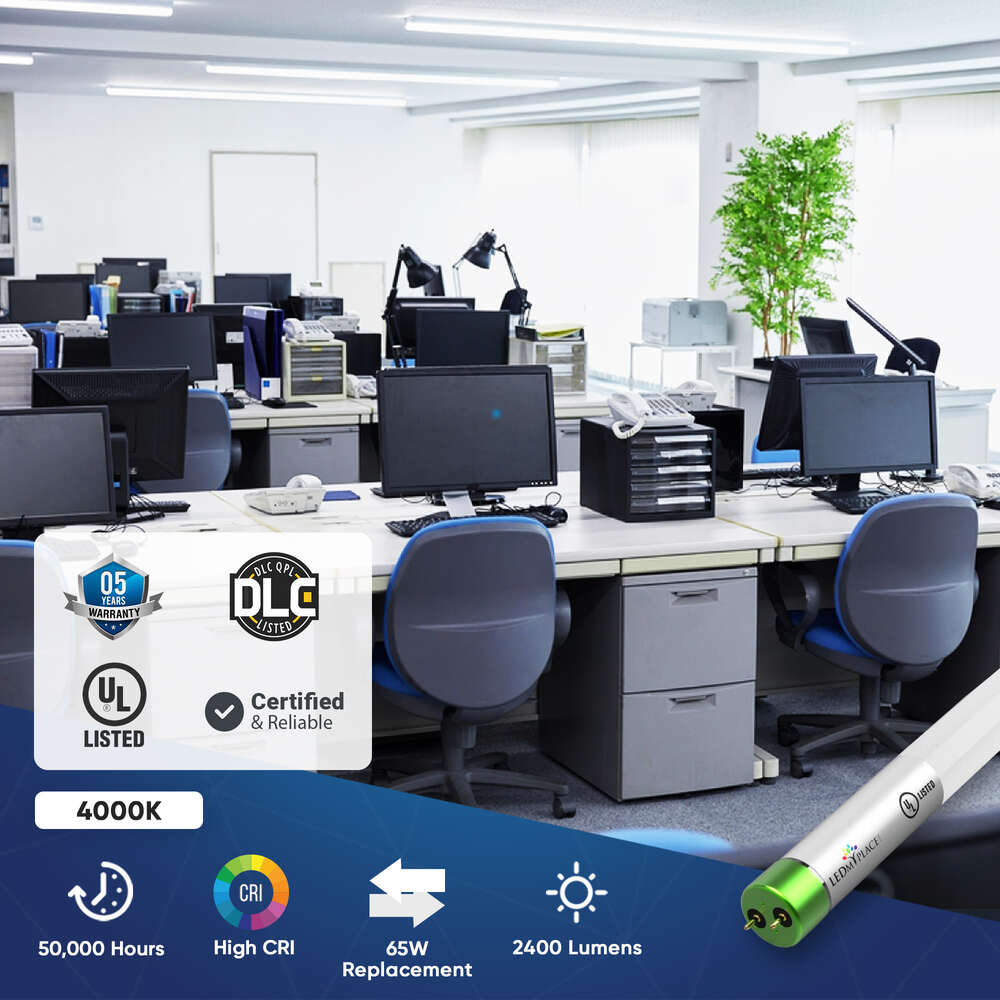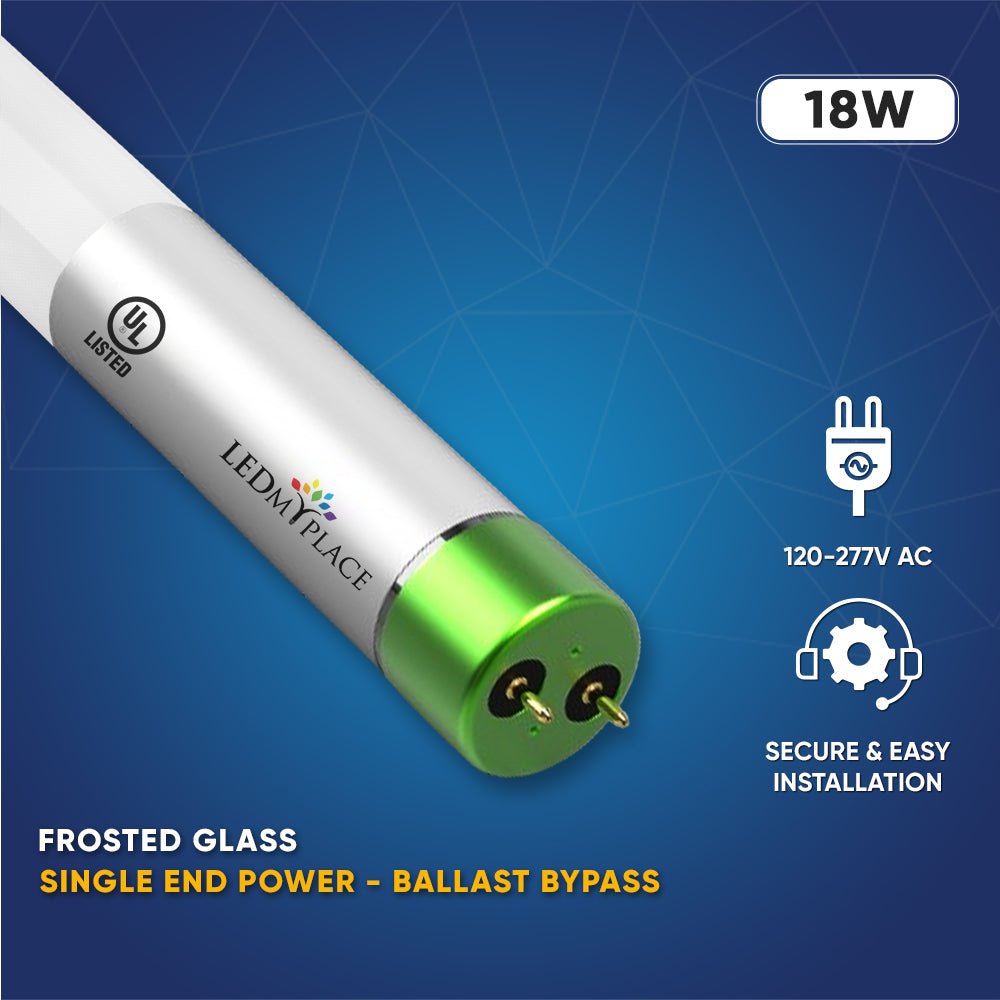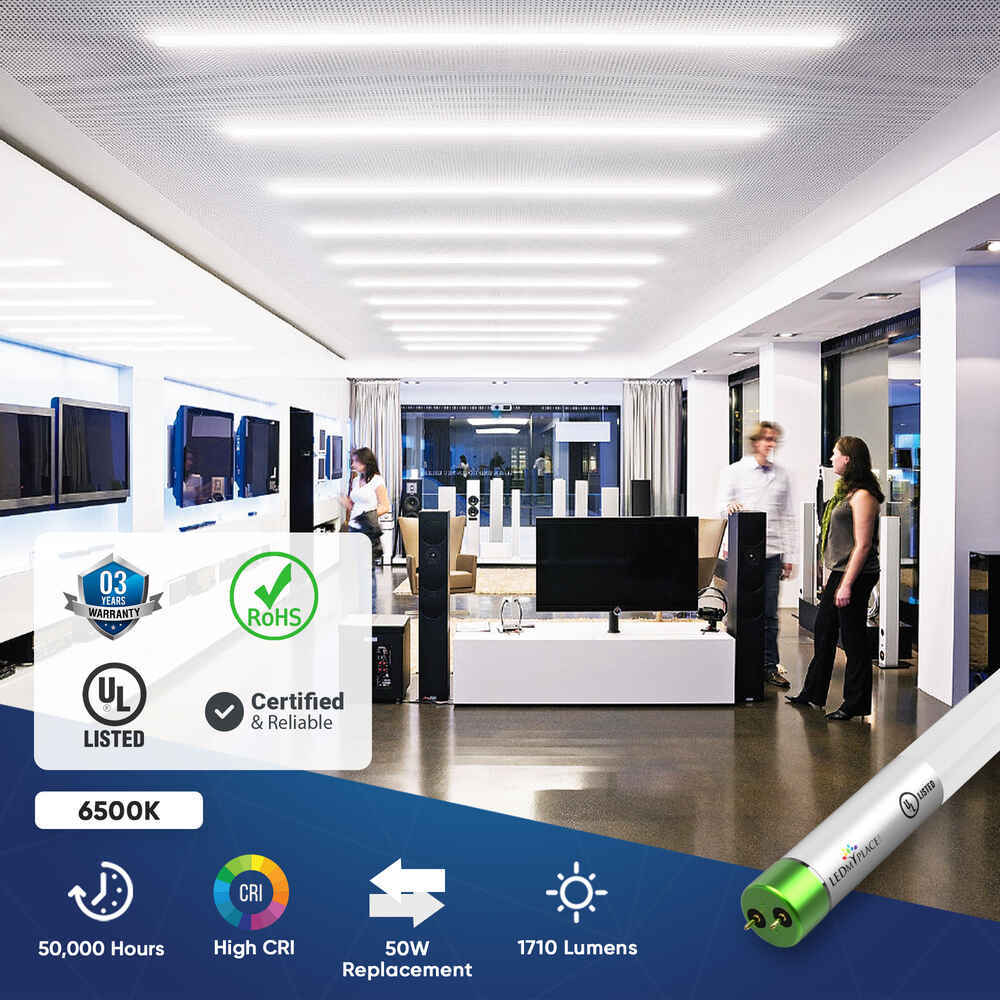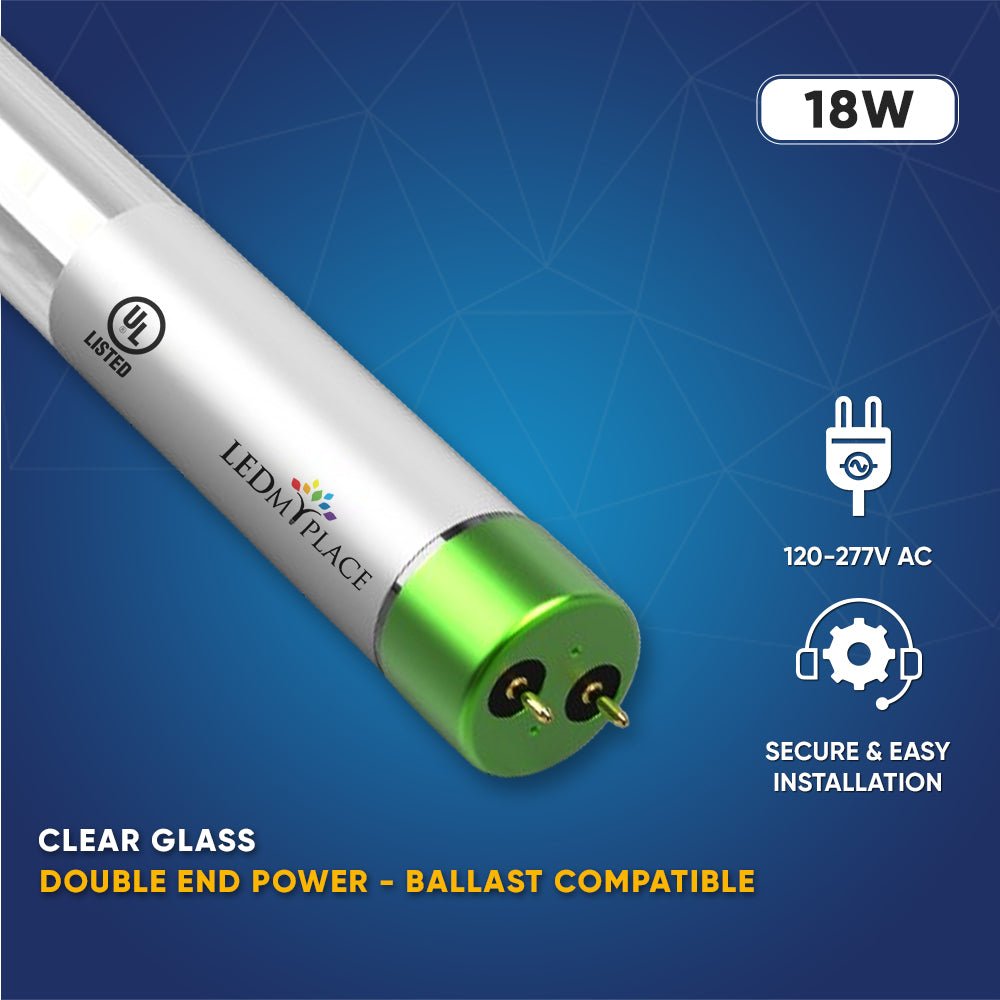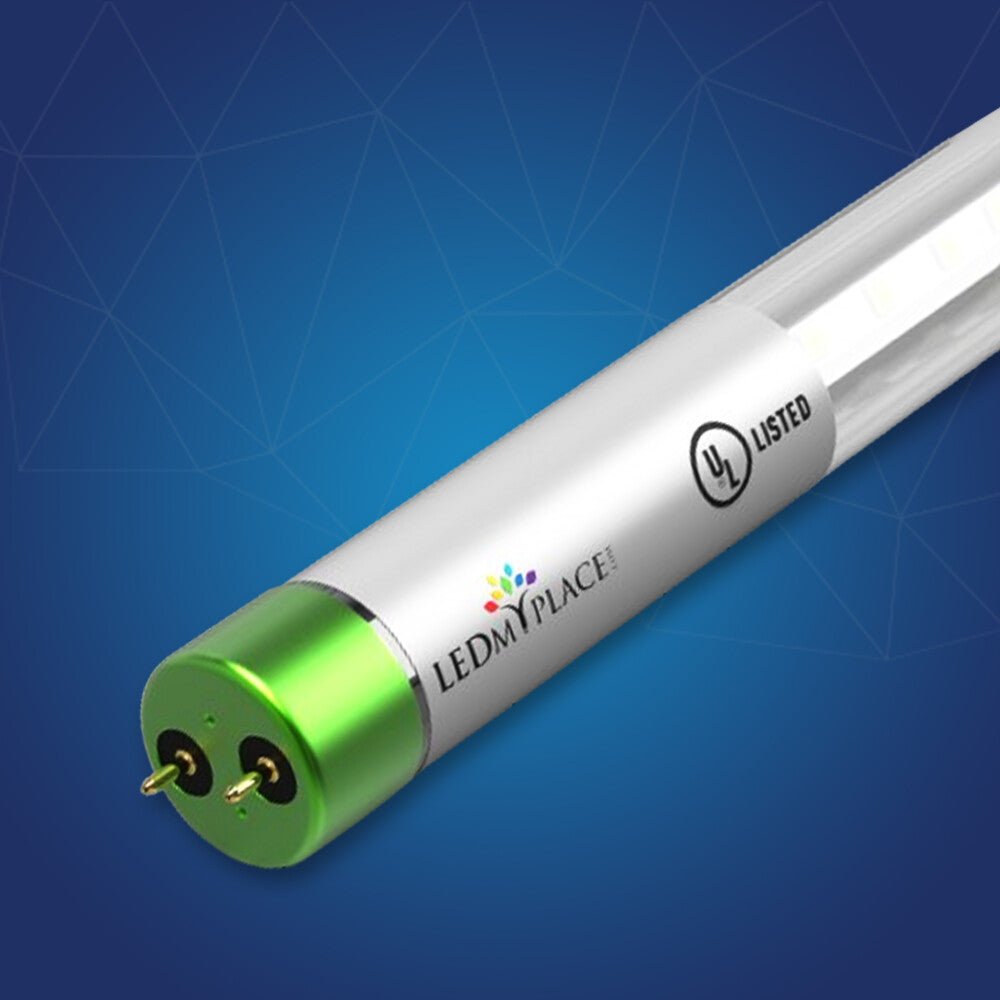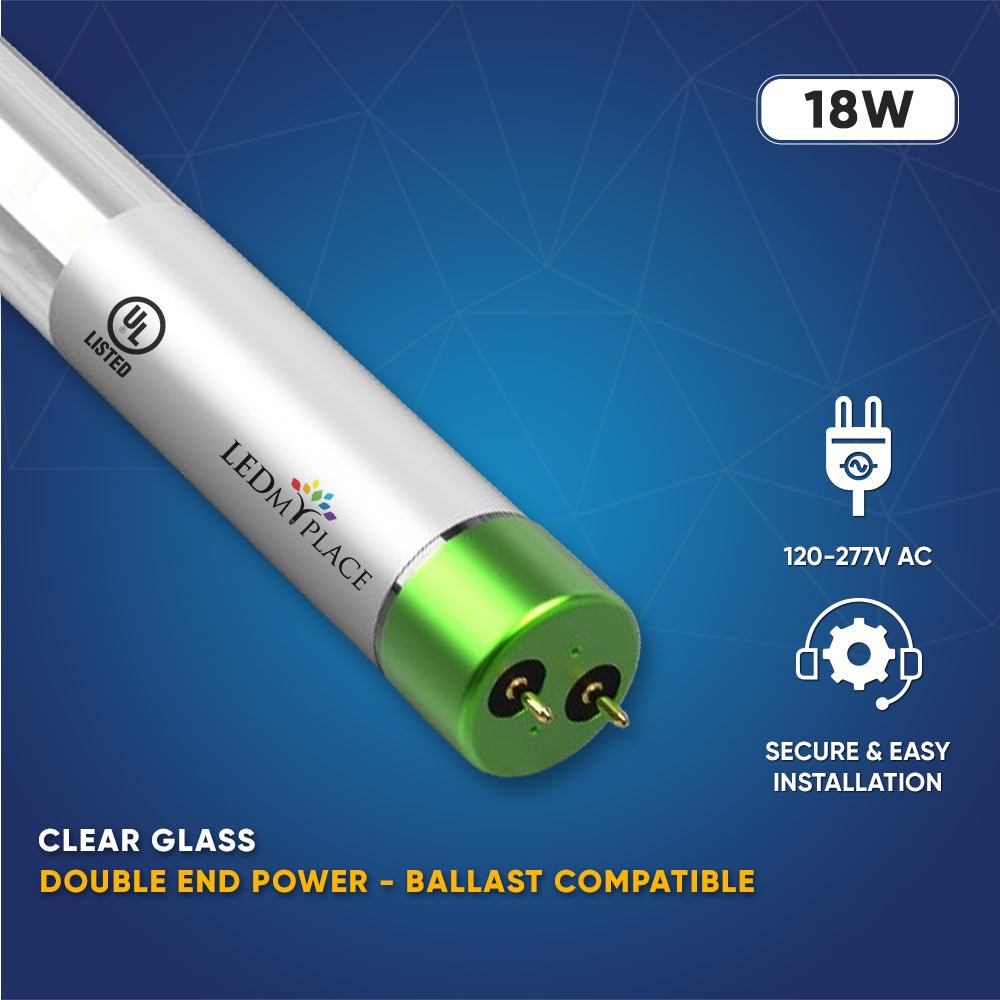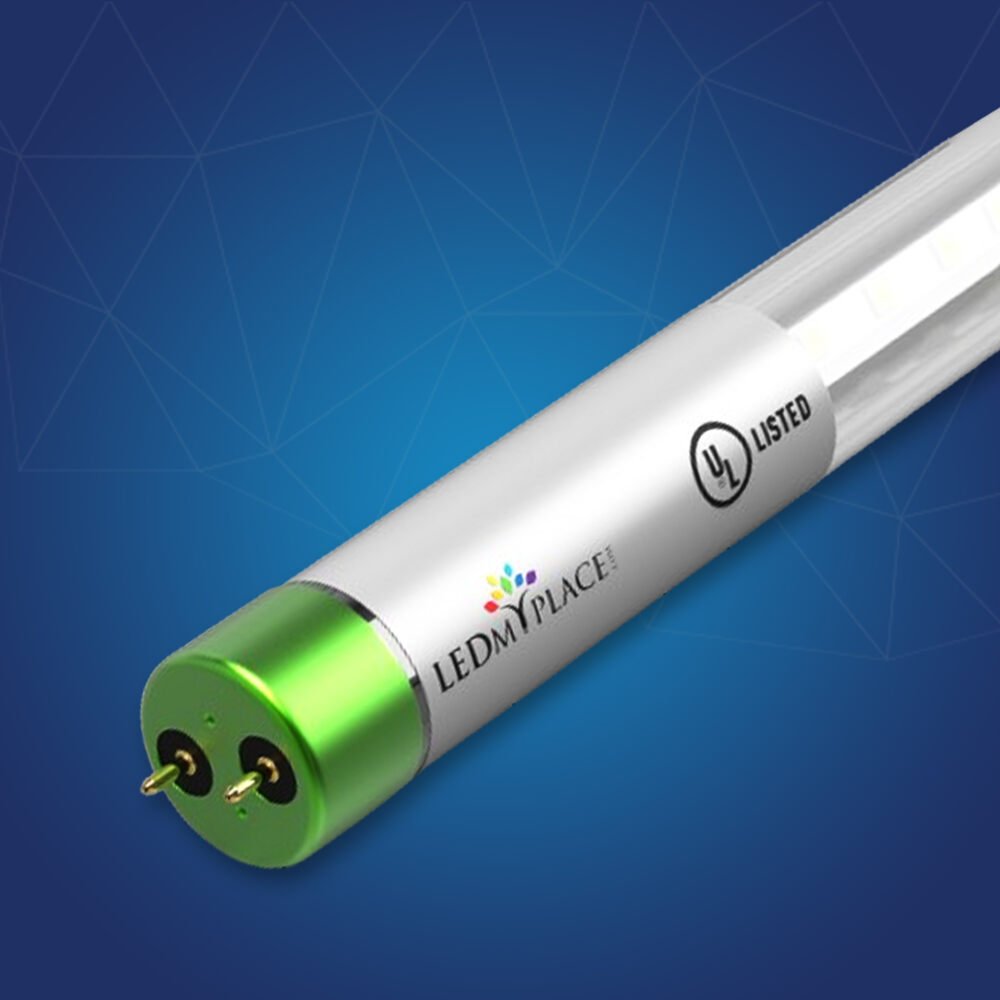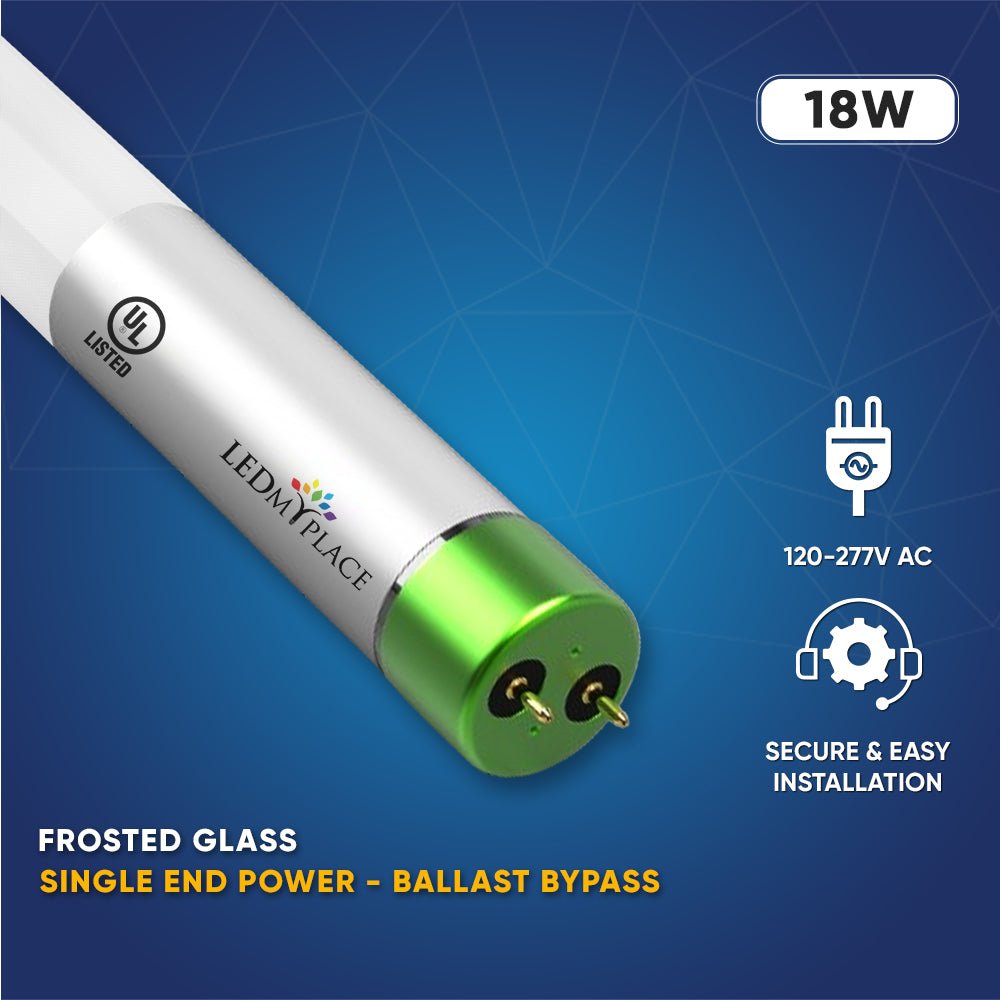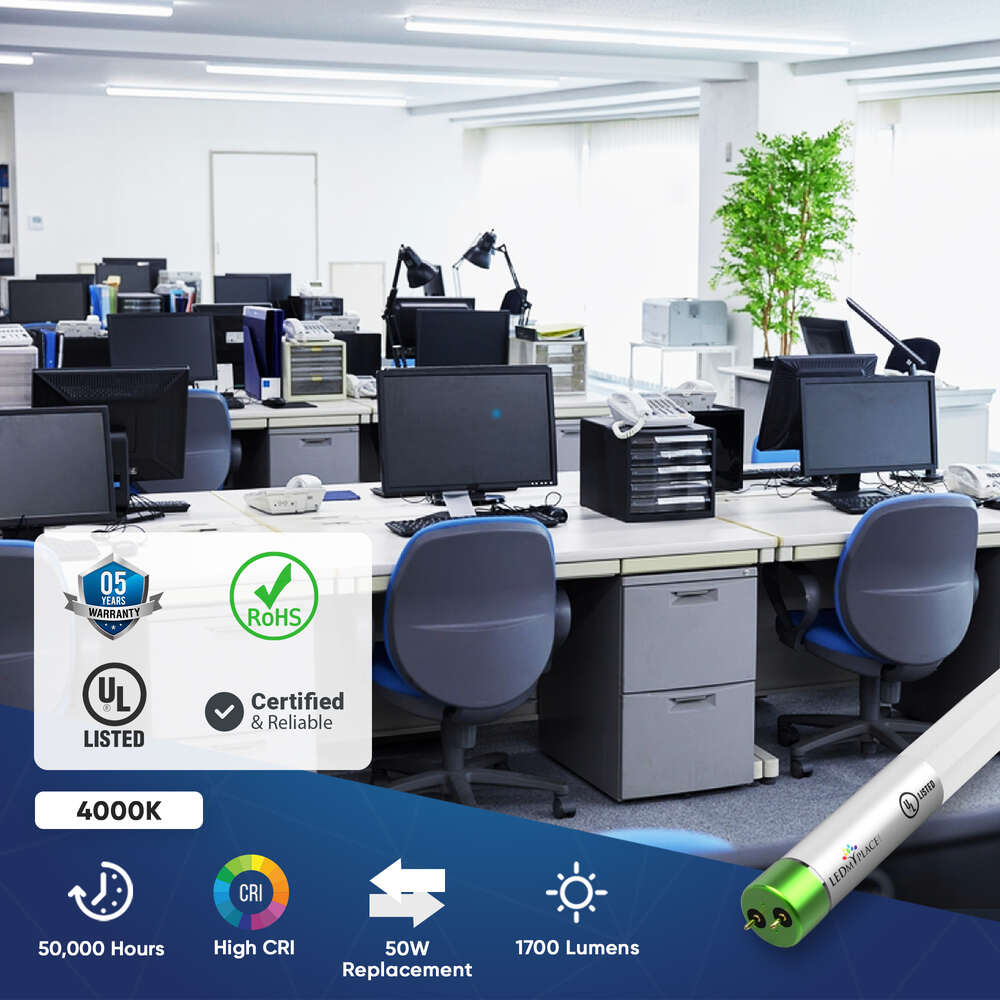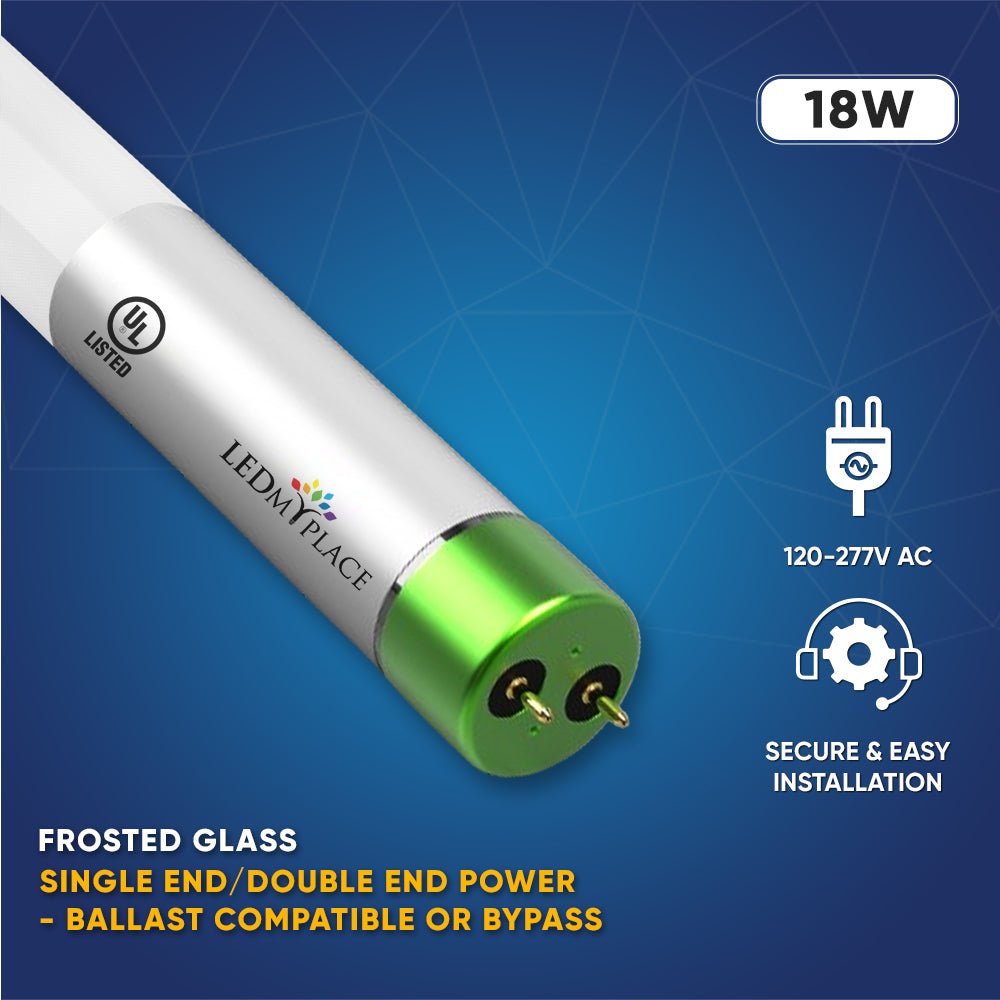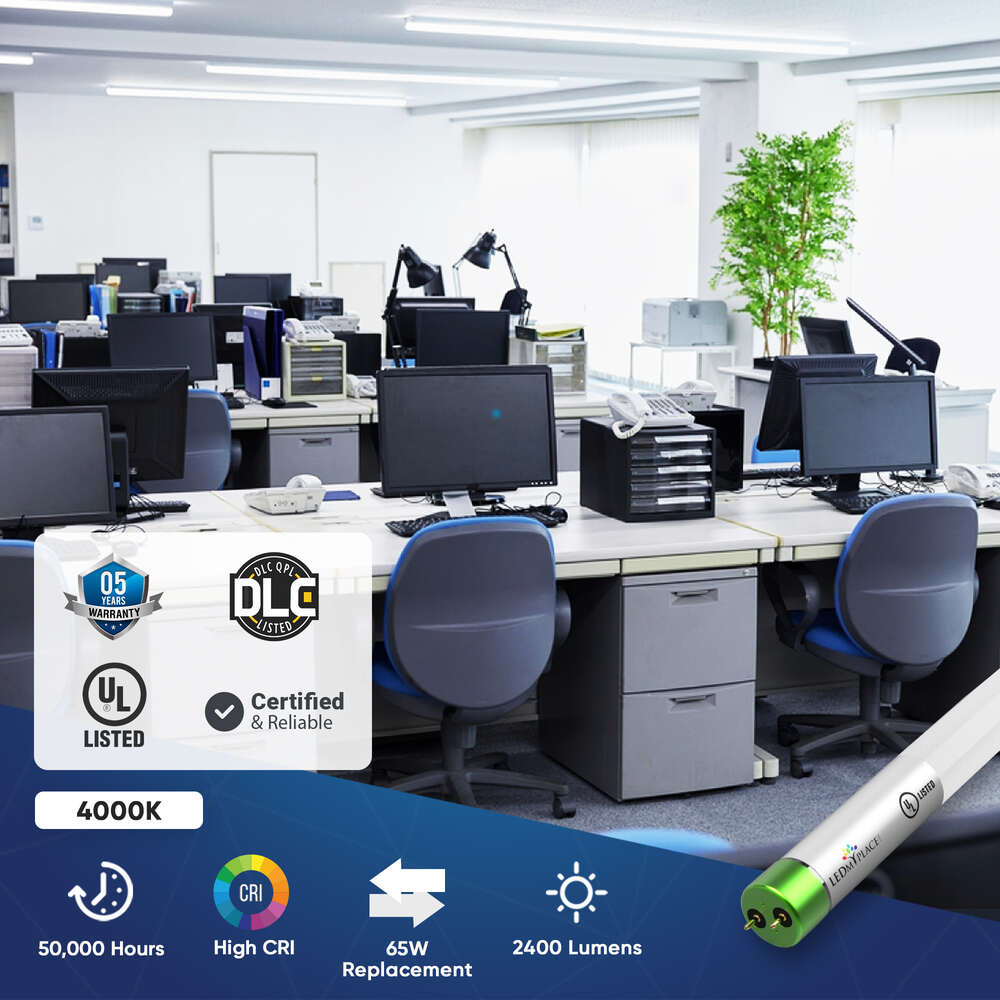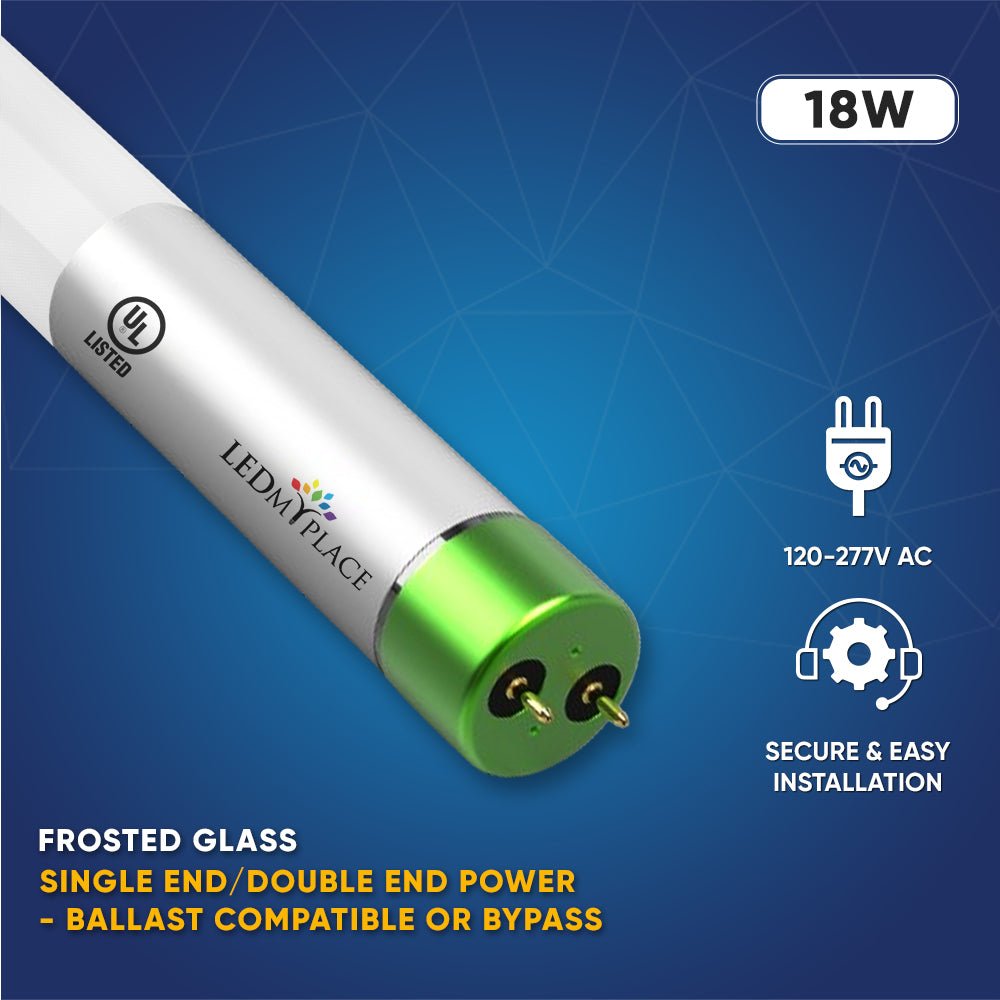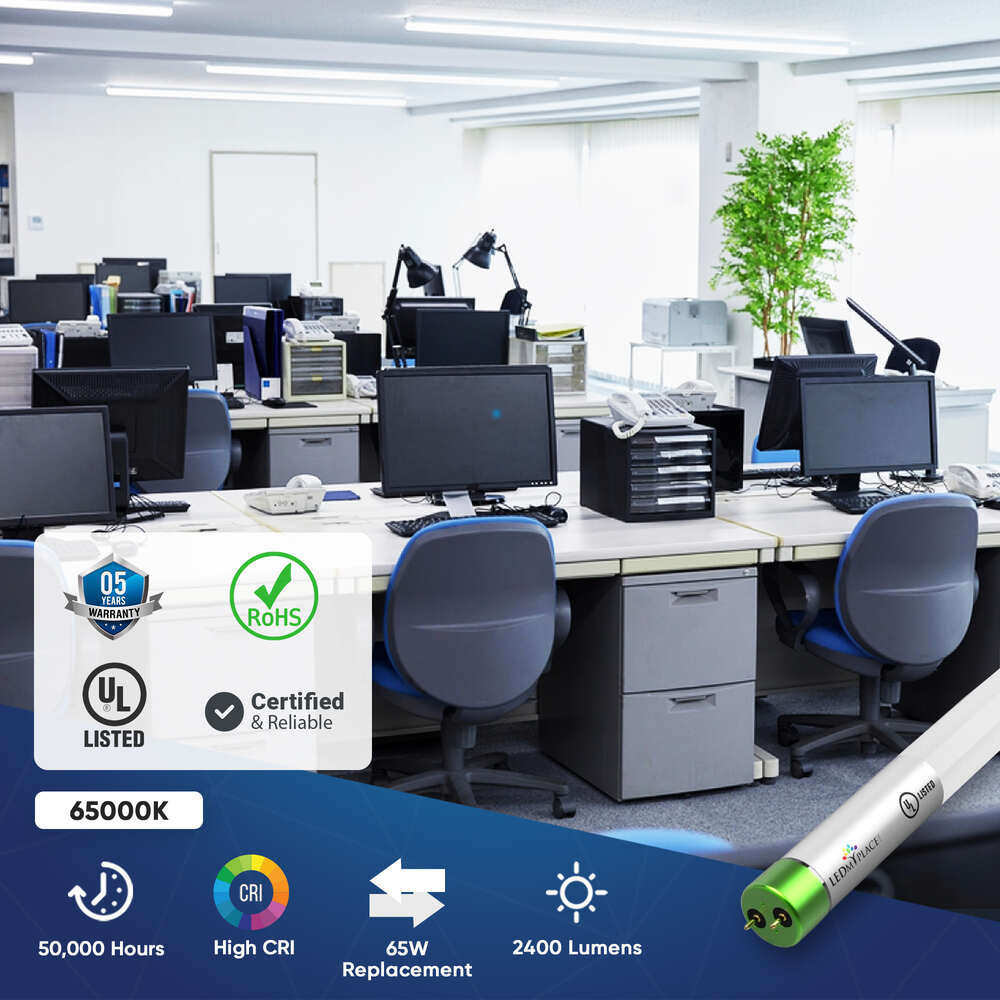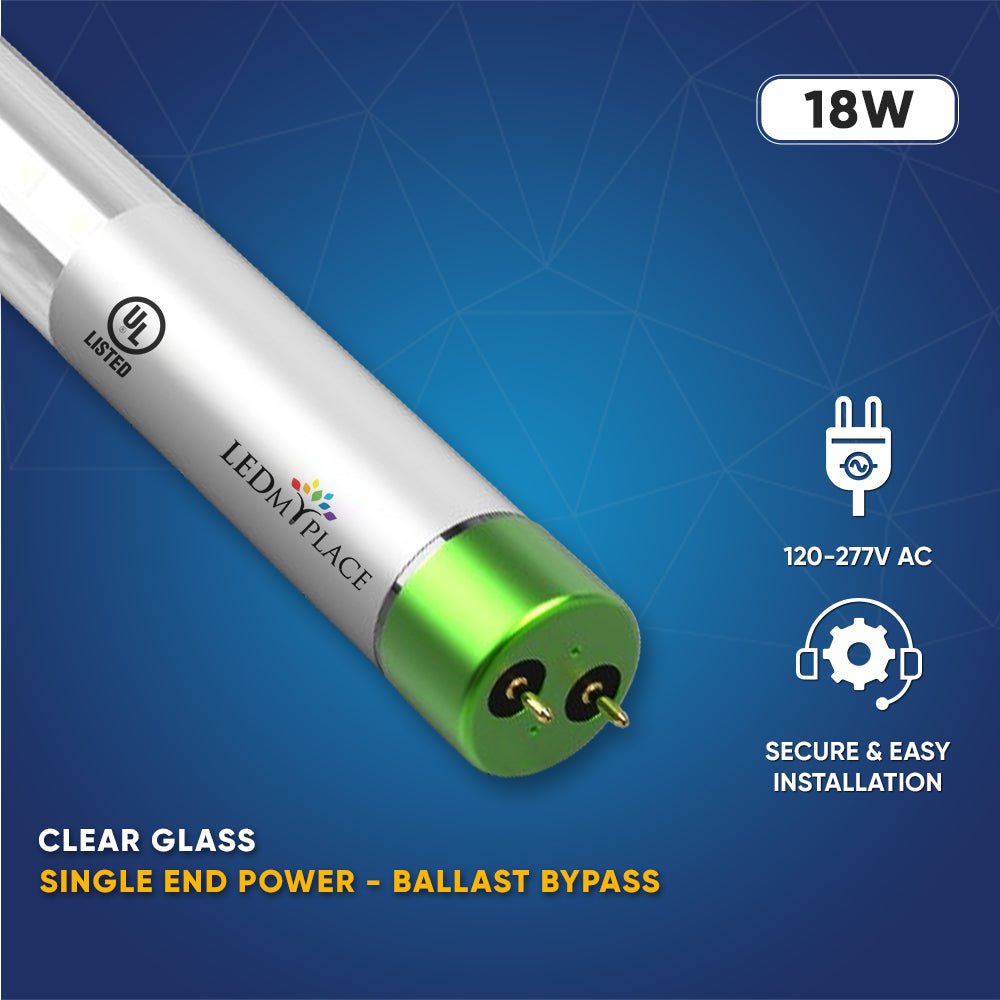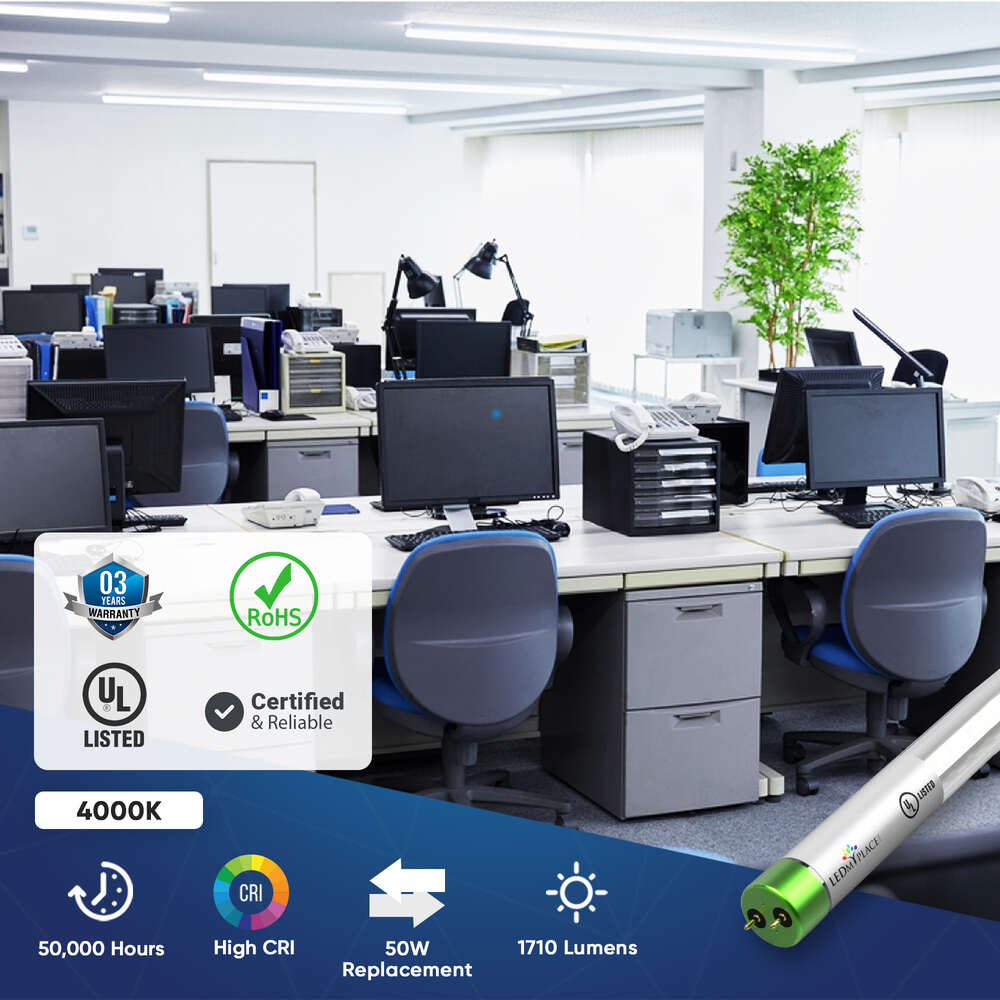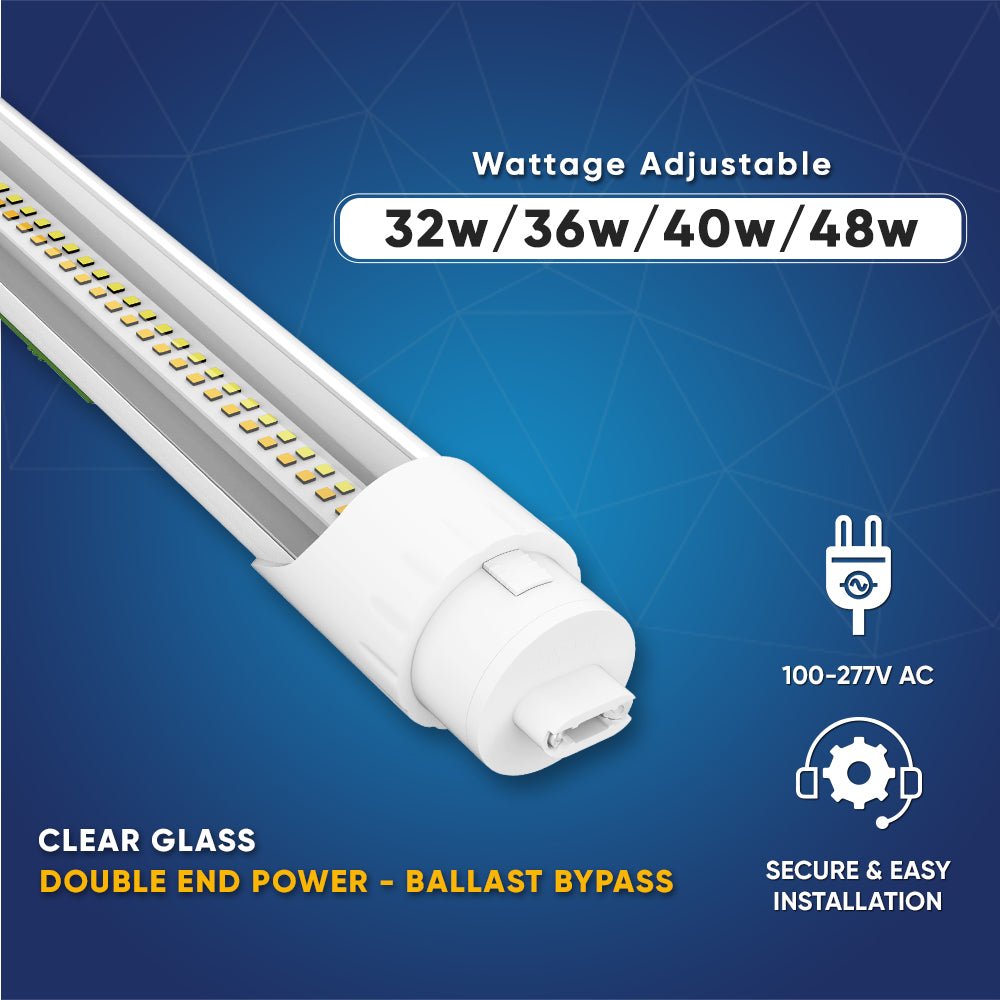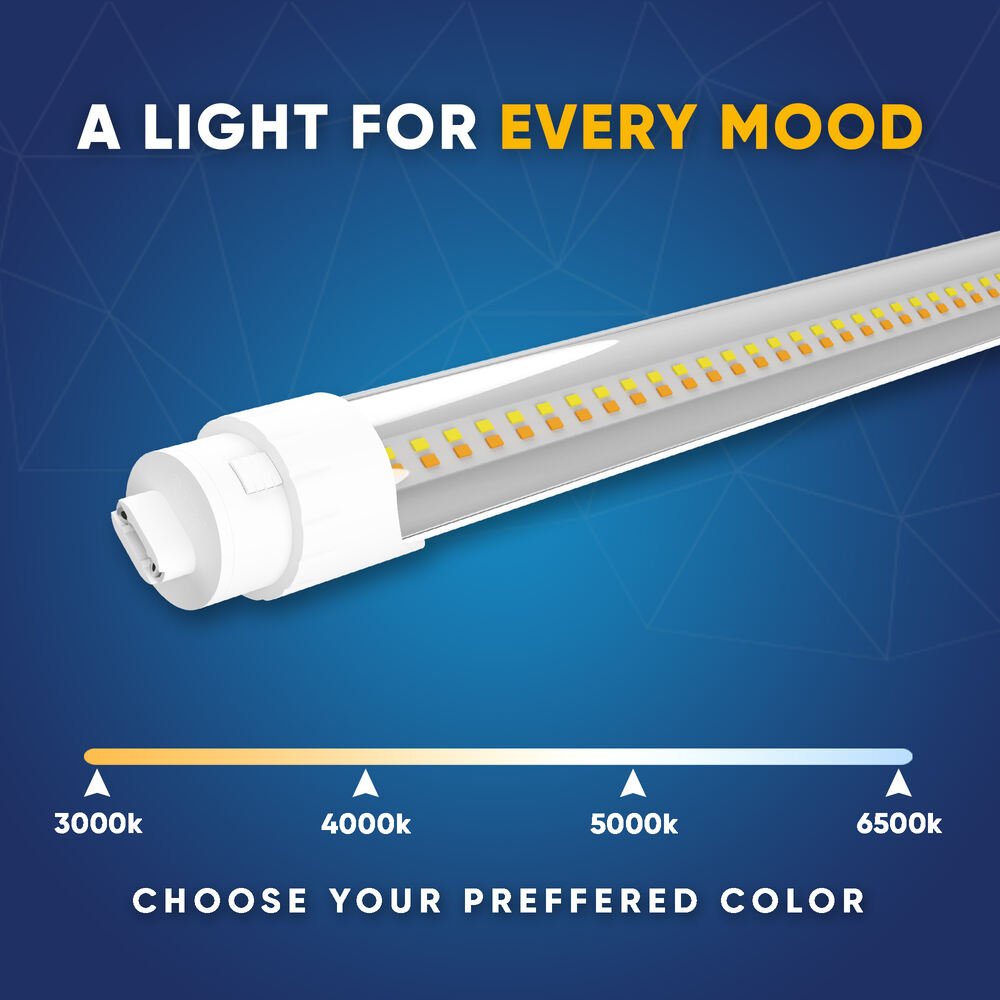Filter and sort
T8 LED Tube Lights | T8 LED Bulbs
-
FREE SHIPPING on orders over $99
- MPN: TB055
- Warranty: 5 Years
Brightness: 4160 Lumens- 6240 LumensWattage: 48w/40w/36w/32wCCT: 3000k/4000k/5000k/6500kLife Hours: 50,000 HoursSold by the case of 1pc
$20.99 Ea.
$20.99 $26.99Save $6.00 (23%)FREE SHIPPING on orders over $99- MPN: TB009
- Warranty: 3 Years
Brightness: 1800 LumensWattage: 18 WattCCT: 5000 KelvinLife Hours: >50,000 Hours$70.99 $129.99Save $59.00 (46%)FREE SHIPPING on orders over $99- MPN: TB060
- Warranty: 5 Years
Brightness: 1560-2860 LumensWattage: 22w/20w/18w/15w/12w/10wCCT: 3000k/3500K/4000k/5000k/6000k/6500kLife Hours: 50,000 HoursSold by the case of 1pc
$8.99 Ea.
$8.99 $12.99Save $4.00 (31%)FREE SHIPPING on orders over $99- MPN: TB006
- Warranty: 5 Years
Brightness: 2400 LumensWattage: 18 WattCCT: 6500 KelvinLife Hours: >50,000 HoursSold by the case of 15-Pack
$6.59 Ea.
$98.99 $145.99Save $47.00 (33%)FREE SHIPPING on orders over $99- MPN: TB059
- Warranty: 5 Years
Brightness: 4160 Lumens- 6240 LumensWattage: 48 WattCCT: 4000 KelvinLife Hours: 50,000 Hours$20.99 $25.99Save $5.00 (20%)FREE SHIPPING on orders over $99- MPN: TB026
- Warranty: 5 Years
Brightness: 1560 Lumens- 2860 LumensWattage: 22w/20w/18w/15w/12w/10wCCT: 3000k//3500K4000k/5000k/6000K/6500kLife Hours: 50,000 HoursSold by the case of 1pc
$8.99 Ea.
$8.99 $12.99Save $4.00 (31%)FREE SHIPPING on orders over $99- MPN: TB003
- Warranty: 3 Years
Brightness: 1800 LumensWattage: 18 WattCCT: 5000 KelvinLife Hours: >30,000 HoursSold by the case of 15-Pack
$4.79 Ea.
$71.99 $129.99Save $58.00 (45%)FREE SHIPPING on orders over $99- MPN: TB008
- Warranty: 5 Years
Brightness: 2400 LumensWattage: 18 WattCCT: 5000 KelvinLife Hours: >50,000 HoursSold by the case of 15-Pack
$5.66 Ea.
$84.99 $145.99Save $61.00 (42%)FREE SHIPPING on orders over $99- MPN: TB012
- Warranty: 3 Years
Brightness: 1800 LumensWattage: 18Wattage Equivalent: 50 Watt ReplacementCCT: 6500 KelvinLife Hours: 50,000 HoursSold by the case of 15-Pack
$4.79 Ea.
$71.99 $129.99Save $58.00 (45%)FREE SHIPPING on orders over $99- MPN: TB004
- Warranty: 3 Years
Brightness: 1620 LumensWattage: 18 WattCCT: 6500 KelvinLife Hours: >30,000 HoursSold by the case of 15-Pack
$4.79 Ea.
$71.99 $116.99Save $45.00 (39%)FREE SHIPPING on orders over $99- MPN: TB005
- Warranty: 3 Years
Brightness: 1800 LumensWattage: 18 WattCCT: 5000 KelvinLife Hours: >50,000 HoursSold by the case of 15-Pack
$4.79 Ea.
$71.99 $116.99Save $45.00 (39%)FREE SHIPPING on orders over $99- MPN: TB017
- Warranty: 3 Years
Brightness: 1800 LumensWattage: 18Wattage Equivalent: 50 Watt ReplacementCCT: 4000 KelvinLife Hours: 50,000 HoursSold by the case of 15-Pack
$4.79 Ea.
$71.99 $116.99Save $45.00 (39%)FREE SHIPPING on orders over $99- MPN: TB019
- Warranty: 5 Years
Brightness: 2400 LumensWattage: 18Wattage Equivalent: 50 Watt ReplacementCCT: 4000 KelvinLife Hours: 50,000 HoursSold by the case of 15-Pack
$6.59 Ea.
$98.99 $145.99Save $47.00 (33%)FREE SHIPPING on orders over $99- MPN: TB015
- Warranty: 5 Years
Brightness: 2400 LumensWattage: 18Wattage Equivalent: 50 Watt ReplacementCCT: 6500 KelvinLife Hours: 50,000 HoursSold by the case of 15-Pack
$6.59 Ea.
$98.99 $145.99Save $47.00 (33%)FREE SHIPPING on orders over $99- MPN: TB011
- Warranty: 3 Years
Brightness: 1800 LumensWattage: 18Wattage Equivalent: 50 Watt ReplacementCCT: 4000 KelvinLife Hours: 50,000 Hours5Sold by the case of 15-Pack
$4.79 Ea.
$71.99 $129.99Save $58.00 (45%)FREE SHIPPING on orders over $99- MPN: TB052
- Warranty: 5 Years
Brightness: 130 Lumens/wWattage: 32/36/40/48W Wattage AdjustableCCT: 3000K/4000K/5000K/6500K CCT ChangeableLife Hours: 50,000 HoursSold by the case of 1pc
$20.99 Ea.
$20.99 $27.99Save $7.00 (26%)About T8 LED Tube Lights | T8 LED Bulbs
T8 LED Tube Light Fixtures are a safe, energy-efficient choice for shops, offices, storage areas, fabrication floors, and mechanic garages. Don’t change your entire fixture as we have ballast- compatible/ Without Ballast/ Hybrid T8 LED Bulbs available in different sizes and wattages. T8 LED Tubes are an energy-efficient replacement for fluorescent lights in parabolic and indirect light fixtures, which performs in its best way in climate-controlled areas with standard ceiling heights.
To help you get out of this dilemma, we have come up with this guide. It will help you through the process of picking the right kind of tube so that you don't waste your valuable time and money.
This guide will not only take you through everything that is there to know about light-emitting diode (LED) tubes; but also inform you about the importance of replacing your old fluorescent tube lights.
Without further delay, let's dive into the bright world of T8 and other tube light fixtures.

What are LED and Fluorescent technologies?
Since the advent of lighting technology, there has been a lot of advancement, just like any other industry. In a series of research and development achievements, LEDs are the latest and the most advanced form of lighting fixtures available today. These represent the fourth generation of lighting technology and succeed fluorescent lighting fixtures in the sequence.
To understand which of the two technologies (LED or Fluorescent) is better, you will first have to know how they work.
Let's start by looking at how LEDs work.
In general, an LED has two plates of semiconductors- one having positively charged particles known as 'holes' and negatively charged 'electrons' on the other. The two plates collectively make up a 'light-emitting diode.'
When an electric current passes through the diode, the holes and electrons move opposite directions, ensuring that holes collide with electrons. Holes exist at a lower energy level then electrons. So, when the two collide, electrons lose some energy in the form of photons, i.e., light.
Thus, as a result of the movement of atoms, LEDs (semiconductors) emit light. The number of photons that release during the movement (of electrons and holes) determines an LED fixture's luminosity. However, LED manufacturers can manipulate the luminosity (lumen output) by adding impurities (by a process known as doping) in the semiconductor. Doping, or adding impurities to a semiconductor (LED), allows manufacturing LED lights in various colors (such as red, blue, green, orange, etc.) and hues (such as warm white, cool white, and daylight white).
HOW FLUORESCENT TUBES WORK
Unlike LED technology, Fluorescent lighting works on a different principle. The ends of fluorescent tubes have tungsten filaments which heat up in response to a magnetic field generated by the AC flowing through the circuit.
Now, the heated filament results in the flow of electricity. The starter in the lighting fixture enables the flow of electricity. There is also a 'ballast' present in the fluorescent tubes' fixture, which controls the flow of electricity to prevent the filament from overheating. Thus, it is crucial to have a ballast, for without it, the filament will overheat, and the tube will explode (probably).
The inside of the tube contains a mixture of Argon and Mercury vapor, which mostly emits ultraviolet light. Various chemicals with a specific property called 'fluorescence' convert this UV light into visible light. These chemicals form a coating on the inside of the tube to help create a spectrum of colors.
The LED technology offers several advantages over fluorescent lighting technology. Energy efficiency and eco-friendly properties are at the tips of this iceberg.
In the next section, we will detail the advantages LED tube lights have over the conventional counterparts.
WHY SHOULD YOU PREFER LED TUBE LIGHT OVER FLUORESCENT TUBES
As you may know from reading the above section, LED tube lighting fixtures work on a cleaner and more efficient process. Operating an LED does not involve gas, heating of filament, and the requirement for additional components (like ballasts and starters). However, some LED tube lights do support ballast.
Digging deeper, you will realize that LEDs offer many advantages. Once you choose to install LED fixtures, you'll never go back to conventional lighting technologies.
Let us have a detailed look at what T8 LED bulbs offer
Efficiency: LEDs offer energy efficiency, as no other technology has ever. They convert up to 95% of electrical input into bright light. Thus LEDs lose only 5-10% of input energy in the form of heat. Therefore, they allow massive savings of up to 75% on utility bills. The efficiency also means that a lower watt LED Light can replace a much higher watt fluorescent light.
For instance, an 18W LED fixture produces an equal amount of light as a 50W fluorescent. The use of LEDs also results in a decrease in one's reliability on the utility grid. They also result in less emission of greenhouse gases, making LEDs eco-friendly as well.
High CRI: The color rendering index is a measure of how accurate the colors are in comparison with daylight. A low CRI light would render inaccurate colors that appear far from what they would look like under broad sunlight.
CRI ranges from 0 to 100, where 0 means every color will look the same, and 100 means true or accurate colors. Fluorescent tubes that have a high CRI are energy guzzlers. Thus, they are not a popular choice. On the other hand, LEDs commonly hover between a CRI of 80-90 while providing higher power efficiency.
Long-lasting: LED lights have no moving parts; they do not radiate excessive heat and do not have any fragile components. Thus, they provide a longer lifespan. These lights go through a rigorous testing period of 50,000 hours, so they offer a lifespan of the same duration.
Meaning that an LED lighting fixture is not a sprint runner but a marathon runner with a sprint runner's speed. Having the capacity to function 24 hours for 5.7 years (approx), LED fixtures can operate up to 11.4 years if used 12 hours a day.
CCT: CCT or 'correlated color temperature' determines the hue of the white light from LEDs. The CCT measures in Kelvin.
- If the color temperature is less than 2000 Kelvin, it determines a dim glow of light, similar to candlelight. This CCT is ideal for places where ambient light is preferred.
- 2000-3000 Kelvin is the range in which a soft white light often appears yellowish. This CCT is often used for lighting the living room, dining room, bedrooms, etc.
- 3100-4500 Kelvin gives a bright white light that finds its uses in kitchens, offices, workspaces where task lighting is needed.
- 4600-6500 Kelvin is similar to daylight and is best for display areas and places where very bright illumination is required.
- Lighting with a CCT of more than 6500 Kelvin is a bright bluish hue of light and is best for places where very bright illumination is needed.
Now that we have a fair understanding of 'What LEDs are and their advantages over conventional lights,' we will now take you through the various types of tubes.
THE BRIGHT WORLD OF T8 LED BULBS
T8 fixtures are indoor lighting appliances that are most commonly used in offices, homes, and other places. These lights can replace traditional fluorescent tubes and work best with standard ceiling heights.
While deciding to switch from fluorescent tubes to LED, you might get caught up in T8 fixtures' nitty-gritty. At the worst, you may order a product that may not suit your needs.
Tube light fixtures (LED) come in various configurations, each with a specific set of profiles to fit into your old fluorescent fixture.
Let us now closely examine the different types of light tubes and understand how to pick one.
LED tubes are classified according to a variety of factors. Those factors are the size; Ballast Compatibility; the pin of the tube, the material of the tube's encasing; the clarity of the tube's encasing.
LENGTH
Various lengths serve different kinds of purposes. Primarily, these fixtures come in three different sizes, those are:
2 Foot LED Tubes: With a length of 2 feet, this fixture finds its application in smaller indoor spaces.
In this size, the lights come in 8 watts and can replace fluorescent tubes of 50-watt capacity.
4 Foot LED Tubes: This lighting fixture size is appropriate for medium-sized rooms where high light output is needed in a smaller space. The tubes in this size offer three different wattages. 18 watt LED tube replaces a 40-watt fluorescent fixture. Twenty watts LED light is a suitable replacement for 50 watts fluorescent Light. 22 watt LED light replaces 60 watts fluorescent light.
8 Foot LED tubes: This tube light size is ideal for installation in large halls and big rooms.
In this length, the tubes come in two different wattages: 40 watts LED replacing 100-watt fluorescent and 48 watts LED replacing 120-watt fluorescent.
DIAMETER
LED lights primarily come in three different diameters. The notation of the diameter is T, followed by the number. T stands for the tube, and the number is a division of 8, which gives the diameter in inches. For example, if you order a T8 tube, this would mean the tube's diameter is 8/8 inch, i.e., one inch. Different sizes of diameters are:
- T5: This means that the tube's diameter is ⅝ inches, which is a thinner model compared to the other two.
- T8: A T8 tube with a diameter of one inch and is slightly thicker than T5.
- T12: A T12 tube is the one with a diameter of 1.5 inches, and it is the thickest of all.
Ballast Compatibility: When switching from a traditional fluorescent tube to an LED-type, people often choose not to change the entire fixture.
The ballast regulates the need for high voltage to start the light tube. It also helps control the constant voltage to operate a fluorescent tube light. (refer to the upper section of this guide)
There exist three types of LED tubes based on the ballast compatibility. These are:
Type A: This type of tube light is compatible with the ballast and will function properly in your fluorescent tube's old fixture.

- Type B: This type of LED Tube light is not compatible with ballast and will either require the removal of the ballast from the wiring or will need a new fixture to operate.

- Type A+B: This type of hybrid tube can work with or without ballast and is universal when it comes to ballast compatibility.


Tubes differentiated by base:
LEDs are categorized into three different types, depending on the available base. Those are:
Single pin (FA8): As the name suggests, the ends of this type of tube light have a single pin on both ends, which connect with the fixture into the live and neutral wire.
Double pin (R17): This type of LED light has two pins on both ends that connect with the fixture's live and neutral end.
Single-ended: This type of tube fixture has two pins but only on one end of the tube. The other end of the tube is only for support in such tubes.
Difference based on tube's encasing: These tubes come in two different materials covering the main LED strip. These are:
Glass: This type of LED tube offer better heat dispensation and thermal handling than glass because glass has a higher temperature tolerance than plastic.
Plastic: Plastic or polycarbonate tubes have the distinct advantage of being rugged and better tolerant of breakage.
Difference based on the clarity of encasing: Based on transparency, there exist two types of tube fixtures in the market with each serving a different purpose.
Clear: A clear LED tube Light is almost 40% brighter than a frosted one with the same wattage. But the drawback of having a transparent tube is that it is sometimes unappealing to look at. Clear tubes are suitable for use in tunnels and parking lots, where high luminous output is required.
Frosted: Frosted LED fixtures have a coating on the encasing, which makes them opaque. Thus, it allows dimming the light and making it softer and comfortable. The main areas where frosted tube lights come in use are offices, study rooms, and resting places.
Choosing the right tube lighting fixture is not an easy choice, but with this guide's help, you have enough knowledge to shop for all the variety of LED tubes you want.
By writing this guide, we are hopeful that you won't waste time or money on something that won't meet your lighting needs. So, if you wish, feel free to explore our collection of premium-quality LED lights!
Frequently Asked Questions
Q: How does a T8 LED tube light differ from a traditional fluorescent T8 tube?
A: T8 LED tube lights differ from traditional fluorescent T8 tubes in several ways. LED tubes use LED technology, which is more energy-efficient, has a longer lifespan, and does not contain hazardous materials like mercury, unlike fluorescent tubes. LED tubes also offer better light quality, reduced flickering, and instant start-up without the warm-up period required for fluorescent tubes.Q: Are T8 LED tube lights compatible with existing fluorescent fixtures?
A: In many cases, T8 LED tube lights are compatible with existing fluorescent fixtures. However, it's crucial to check the specifications and compatibility of the LED tubes with the existing ballasts. Some LED tubes require the removal or bypassing of the ballast for proper operation.Q: Can T8 LED tube lights be used to retrofit T12 fluorescent fixtures?
A: T8 LED tube lights can often be used to retrofit T12 fluorescent fixtures, but it may require rewiring or bypassing the existing ballast to ensure proper operation. Consult the manufacturer's instructions or a qualified electrician for guidance on the specific retrofitting process.Q: Do T8 LED tube lights produce heat like traditional fluorescent tubes?
A: T8 LED tube lights produce significantly less heat than traditional fluorescent tubes, making them more energy-efficient and reducing the risk of overheating in confined spaces.Q: Can T8 LED tube lights help save on electricity costs?
A: Yes, T8 LED tube lights are highly energy-efficient and can help save on electricity costs compared to traditional fluorescent tubes. They consume less power while providing similar or better light output.Q: Are T8 LED tube lights flicker-free?
A: Yes, T8 LED tube lights are designed to be flicker-free, providing a stable and consistent light output. Unlike some older lighting technologies, LEDs do not flicker at a noticeable rate, reducing eye strain and potential health issues.Q: Are T8 LED tube lights suitable for office lighting?
A: Yes, T8 LED tube lights are commonly used for office lighting due to their energy efficiency, long lifespan, and better light quality. They can provide bright and comfortable illumination for workspaces.Q: Can T8 LED tube lights be used with emergency backup systems?
A: Some T8 LED tube lights are compatible with emergency backup systems, allowing them to operate during power outages. It's essential to use LED tubes specifically designed for emergency lighting applications and ensure compatibility with the backup system.Q: Can you replace fluorescent tubes with LED without removing the ballast?
A: Yes, there are "plug-and-play" LED tubes designed to work with existing fluorescent ballasts, allowing for direct replacement without removing the ballast. However, compatibility should be checked.Q: Do you need a ballast for T8 LED bulbs?
A: T8 LED bulbs come in two main types:- Direct Replacement (Plug-and-Play): These LEDs work with your current ballast.
- Ballast-Bypass (Direct-Wire): These LEDs need the ballast to be removed or bypassed.
- Choosing a selection results in a full page refresh.






